January 1, 2013
12 min read

How Humans Will Evolve on Multigenerational Space Exploration Missions
How future generations will make the voyage from our earthly home to the planets and beyond—and what it means for our species
By Cameron M. Smith
The Science Of The Next 150 Years: 150 Years in the Future When space shuttle Atlantis rolled to a stop in 2011, it did not mark, as some worried, the end of human spaceflight. Rather, as the extinction of the dinosaurs allowed early mammals to flourish, retiring the shuttle signals the opening of far grander opportunities for space exploration. Led by ambitious private companies, we are entering the early stages of the migration of our species away from Earth and our adaptation to entire new worlds. Mars is the stated goal of Elon Musk of PayPal fortune; polar explorers Tom and Tina Sjogren, who are designing a private venture to Mars; and Europe's privately funded MarsOne project, which would establish a human colony by 2023. The colonization of space is beginning now.
But technology is not enough. If space colonization is to succeed in the long run, we must consider biology and culture as carefully as engineering. Colonization cannot be about rockets and robots alone—it will have to embrace bodies, people, families, communities and cultures. We must begin to build an anthropology of space colonization to grapple with the fuzzy, messy, dynamic and often infuriating world of human biocultural adaptation. And we must plan this new venture while remembering the clearest fact of all regarding living things: they change through time, by evolution.
Three main concepts shape current thought about space colonization. First is the colonization of Mars. Widely publicized by the peppery space engineer and president of the Mars Society, Robert Zubrin, Martian colonies would be self-sufficient, using local resources to generate water and oxygen as well as to make construction materials. Next is the concept of free-floating colonies—enormous habitats built from lunar or asteroid metals. Popularized by physicist Gerard K. O'Neill in the 1970s, these would house thousands of people, could rotate to provide an Earth-like gravity (as beautifully envisioned in the 1968 film 2001: A Space Odyssey ), and could either orbit Earth or hang motionless at so-called Lagrangian points, spots where an object's orbital motion balances the gravitational pull of the sun, moon and Earth. Finally, we might also consider the concept of the Space Ark, a giant craft carrying thousands of space colonists on a one-way, multigenerational voyage far from Earth. I have been working with the nonprofit foundation Icarus Interstellar to design just such a mission.
On supporting science journalism
If you're enjoying this article, consider supporting our award-winning journalism by subscribing . By purchasing a subscription you are helping to ensure the future of impactful stories about the discoveries and ideas shaping our world today.
Each of these approaches has its merits, and I think they are all technologically inevitable. But we must never confuse space colonization with the conquest of space. The world beyond ours is unimaginably vast; it will be what it has always been. When humankind begins to make its home in space, it is we who will change.
The Pioneers
Who will be the space colonists? Here we must ditch the old concept of crew selection and the comically diabolical tests of chisel-chinned space heroes depicted in The Right Stuff . Space colonists will be ordinary families and communities who will not be on a mission but who are intending to live out their lifetimes. We will need a few Captain Picards, although most early colonists will most likely be farmers and construction workers.
Still, early colonists will have to be genetically healthy. In smallish populations, individuals carrying genetic maladies could threaten the future in ways that do not play out in a population of billions. In a Space Ark, the biological fate of the colony is strongly conditioned by the genetic constitution of the founding population—if just a few travelers carry the genes for inherited disease, these genes will spread much more thoroughly.
We now know the details of hundreds of genes that cause disorders, from cancers to deafness. (Recently researchers announced that they could screen for more than 3,500 such traits in human fetuses.) A genetic screening program seems clear—if you are carrying certain genes, you remain Earth-bound—but life is not so simple. Many maladies are polygenic—that is, the result of complex interactions among myriad genes. And even though one might carry the gene or genes for a certain disorder, environmental factors encountered during the course of life can determine whether or not those genes are activated in a healthy or unhealthy way.
For example, the human ATRX gene helps to regulate processes related to oxygen transportation. But ATRX activity can be altered by environmental influences as diverse as nutrient intake or a person's state of mind. When ATRX function is significantly modified, oxygen transport is impeded, resulting in seizures, mental disabilities and stunted growth. Thus, one cannot simply screen out people carrying ATRX: everyone has it. In some people, though, based on poorly understood environmental factors, ATRX will go haywire. Can we deselect someone for space colonization for something that might happen?
Complicating matters, we must also ensure broad genetic diversity of the gene pool. If all members of a population are genetically identical, a single sweep of disease could wipe everyone out. (This consideration demolishes the concept of a genetically engineered superrace of space travelers, as depicted in the 1997 film Gattaca .)
Once screened, what should be the population of space colonies? In a Mars colony, populations can grow and expand into new territory. But in a Space Ark, the population will be relatively low, and inbreeding becomes a concern. For example, in a study of Amish, Indian, Swedish and Utah populations, infant mortality was roughly double when matings occurred between first cousins than when they occurred between unrelated people.
To avoid these issues, we will have to consider the minimum population needed to maintain a healthy gene pool. Our minimum viable population has been much debated, but several anthropologists have suggested a figure of about 500. Because small populations are always at greater risk of collapse, I would suggest beginning with a population at least four times that at minimum—2,000, or about half the size of a well-staffed aircraft carrier—in a spacecraft that gives this population ample room to grow. For humans away from Earth, safety will indeed be found in numbers. (Even interstellar voyages will focus on reaching another solar system and inhabiting its planets, where populations can grow again.)
We will also have to carefully consider the crew's demographic structure—the age and sex of colonial populations. Simulations by my colleague William Gardner-O'Kearney show that over a few centuries, populations that begin with certain ratios of young to old and males to females persist better than others.
Early colonial populations, then, should be individually healthy and collectively diverse to give future populations the best chance of having genes on hand that might be adaptive in new environments. But we cannot control everything. At some point we will have to roll the genetic dice—which we already do every time we choose to have children on Earth—and set out from cradle Earth.
Space-Based Selection
No matter how carefully we prepare our colonial populations, life off planet Earth, at least at first, will be more dangerous and perhaps shorter than life here. Away from Earth, people will be exposed to forces of natural selection that we have removed from modern life. Little of this selection will play out in the dramatic ways we might expect from science-fiction movies, which tend to focus on the lives of adults. Instead it will occur during critical periods of tissue development in embryos and infants, when life is most delicate.
How could such selection play out? For one example, consider that the human body has evolved close to sea level under an atmospheric pressure of roughly 15 pounds per square inch (psi) for the past several million years, breathing a mix of roughly 80 percent nitrogen and 20 percent oxygen. Yet space travel requires pressurized habitats that grow more expensive and laborious to build the more pressure they need to hold. To ease the engineering requirements, atmospheric pressure in any off-Earth structure will be lower than on Earth.
Fair enough— Apollo astronauts survived just fine at 5 psi—but if you lower atmospheric pressure, you must increase oxygen as a percentage of what you are breathing. (Those same astronauts breathed 100 percent oxygen on their lunar voyages.)
Unfortunately, lower atmospheric pressure and elevated oxygen levels both interfere in vertebrate embryo development. Miscarriages and infant mortality will rise—at least for a time. Inevitably, selection will preserve the genes suitable for extraterrestrial conditions and remove those that are less suitable.
Infectious disease—to which small, dense populations such as space colonies are particularly vulnerable—will return as a significant concern, imposing new selection pressures as well. However careful we are with immunization and quarantine, plagues will eventually sweep through colonies, resulting in selection for people more capable of surviving the disease and selection against those less capable.
Finally, we must remember that we bring with us thousands of domesticates—plants and animals for food and materials—and that selective pressures will act on them as well. Ditto the millions of microbial species that ride on and in human bodies—invisible genetic hitchhikers that are critical to our health [see “The Ultimate Social Network,” by Jennifer Ackerman; Scientific American, June 2012].
Based on a few calculations, I think it is reasonable that within five 30-year generations—about 150 years—such changes will be apparent in the extraterrestrial human body.
Exactly what biological adaptations evolve will depend heavily on the atmospheric and chemical environments of the habitats we build. We can control these to a large extent. Yet we cannot easily control two other important factors that will shape humanity in space: gravity and radiation.
Mars travelers will feel just a third of Earth's gravity. Those conditions will select for a more lithe body stature that can move with less effort than the bulky, relatively muscular builds we use to counteract Earth's gravity. In Space Ark and other free-floating scenarios, gravitation might remain about Earth normal, so Earth-normal statures might persist.
Radiation causes mutations, and any space colony will be unlikely to provide the protection from radiation that Earth's atmosphere and magnetic field provide. Will increased mutations create physical errors—repeated parts like an extra finger or malformed parts like a cleft palate? Certainly, but we cannot know what kind. The only thing we can predict with confidence is selection for increased resistance to radiation damage. Some people have better and more active DNA-repair mechanisms than others, and they will be more likely to pass their genes on.
Could more efficient DNA-repair mechanisms have any visible correlate—such as, say, a particular hair color? Again, we do not know. But it is also possible for beneficial genetics to spread when they have no such visible correlates. Among Hutterites of South Dakota, who interbreed among a relatively small number of small communities, anthropologists have found that people appear to be strongly influenced in their mate choice by body aroma—and the better the person's immune system, fascinatingly, the better the aroma.
On a moderate, five-generation timescale, then, human bodies will be subtly reshaped by their environment. We will see adaptations on the order of those of the natives of the high Andes and Tibet, where more efficient oxygen-transport physiology has evolved, resulting in broader and deeper chests. Each alteration is a compromise, however, and these high-altitude populations also sustain higher infant mortality when giving birth at altitude. One cultural adaptation to this biological change has been for mothers to descend to oxygen-richer altitudes to deliver children. We can expect similar biocultural shifts off of Earth, and we should plan for the most likely of them. For example, on Mars, birthing mothers might shuttle to an orbiting station where delivery could happen in a rotating, 1- g facility with a more Earth-normal atmosphere, but I bet that eventually they would not bother and that distinctive Martian human characteristics would evolve.
A Space-Based Culture
Cultural change will be more apparent than biological change on a 150-year time span. Studies of human migrations have taught us that while migrating peoples tend to carry on some traditions to maintain identity, they also devise novel traditions and customs as needed in new environments. For example, the Scandinavians who first colonized Iceland after A.D. 800 continued to worship Norse gods and speak the Viking language but quickly developed a distinctive cuisine—heavy on meat (whereas rye and oats were grown in Scandinavia) and on preserved foods to survive the harsh winters—as they explored the resources of an unknown land.
On Mars, this acculturation will play out in innumerable ways. There, in low-pressure, oxygen-rich atmospheres contained in unique architectural materials and arrangements, sound might propagate differently—even if subtly—perhaps affecting pronunciation and even the pacing of speech, resulting in novel accents and dialects. The lighter gravity could influence body language, an important element of human communication, and would influence performance arts of all kinds. Cultural divergence occurs as just such small, innumerable differences accumulate.
More profound cultural change could occur in Space Ark scenarios, where life would have less to do with Earth at each moment that the starship speeds away. Here basic concepts of space and time could well be transformed rather quickly. For example, how long would Space Ark cultures use Earth timekeeping? Without Earth's days and nights and years, civilizations might invent a base-10 timekeeping scale. Or they might decide to count time down until a distant solar system is reached rather than up from some event in the past (such as the departure from an Earth to which they will never return).
Long-Term Genetic Change
Significant genetic change occurs when new genes become widespread in a population. An example from prehistory is the spread of genes that resulted in lactose tolerance in adults, which appeared independently in both Africa and Europe not long after the domestication of cattle. This genetic equipment allowed more energy to be derived from cattle, and in these populations, it quickly became nearly universal, or “fixed.”
Although we cannot predict which mutations will arise, population genetics enables us to estimate how long it would take mutations to become fixed in the genome of space-based explorers. My calculations—based on model Mars populations of 2,000 people of certain age and sex structures—indicate that it could occur in just a few generations and certainly within 300 years; we can expect significant original off-Earth physical characteristics in human populations on this timescale. These changes will be on the order of the broad geographical variation we see in humans today—a spectrum of different statures, skin colors, hair textures and other features.
On Mars, there might be further, internal divergence as some populations elect to live most of their lives sheltered in underground habitats, while others prefer to take the increased radiation risks to live in surface habitats offering greater mobility. In the limited-population, closed-system Space Ark scenario, gene fixation could happen much more rapidly, perhaps driving a greater uniformity than on Mars.
Whereas there will be some biological change, long-term cultural change will be more profound. Consider that in the three centuries from the early 1600s to the early 1900s, the English language changed so much that comprehending 17th-century English texts today requires special training. Three centuries hence, the language spoken on a Space Ark might be profoundly different.
Larger-scale cultural change is also quite likely. Exactly what divides one culture from another is a topic of tremendous debate in anthropology, but I believe that anthropologist Roy Rappaport made the distinction clear. Different cultures have different “ultimate sacred postulates”—core concepts, usually unquestionable and unquestioned, ingrained by tradition and ritual, that shape a population's essential philosophical and moral codes. For Christianity, for example, one such postulate is that “In the beginning, God created the heaven and the Earth.” How long it will take for such foundation beliefs to change off of Earth—and in what direction—is impossible to say, but several centuries is certainly enough time to allow new cultures to arise.
The Rise of Homo extraterrestrialis
When will we see even more fundamental biological change—that is, speciation? Small populations can change quickly, as evidenced by the unusually large mice that roam the Faroe Islands 1,200 years after Viking ships dropped off ordinary house mice. But anatomically modern humans have gone more than 100,000 years—migrating from Africa into a wide variety of environments, from desert to open ocean—apparently without biological speciation. (Our nearest hominin relatives, such as the cold-adapted Neandertals and the apparently miniaturized “hobbit” humans of the island of Flores in the western Pacific, split from our common ancestor substantially earlier.) This is largely because we use culture and technology to adapt more than biology alone. It would take, then, significant natural and cultural selection to reshape extraterrestrial humans to such a degree that they could no longer productively mate with earthlings.
Unless, of course, humans devise their own speciation. It seems inevitable that off-Earthers will eventually harness the staggering power of DNA to tailor their own bodies for many conditions. Perhaps the people of Mars will biologically engineer gill-like structures to split the oxygen from atmospheric carbon dioxide or toughened skin and tissues to endure low pressure. They might make themselves into a new species, Homo extraterrestrialis , by conscious choice.
Where to Begin?
Human space colonization will require plenty of engineering and technical advances. We must also improve our understanding of how human biology and culture adapt to new conditions and use that knowledge to help space colonization succeed. I suggest beginning immediately with three courses of action.
First, we must abandon the technocrat's essential revulsion of humanity and begin procreating off of Earth, giving birth there and raising children there, to understand critical issues of human reproduction, development, and growth in new radiation, pressure, atmospheric and gravity environments. Bureaucrats will recoil at the risks involved—children exposed to risk beyond that of a bicycle-helmeted, First World suburbanite!—but concerns will diminish as space access is privatized. Still, at times the adaptation to space will be painful—but so is birth.
Second, we must experiment with growing and maintaining the health of domesticated species off of Earth. We are going nowhere without our microbes, plants and other animals.
And to promote these first two goals, an X-Prize should be awarded for the first functional, livable human habitat off of Earth: not a sterile orbiting laboratory (as important as those are), but a home where people can grow plants, raise animals and even have children. Many would shudder at the prospect of staying in such a place, but at the same time, there will be no shortage of volunteers.
Finally, we must reengage the proactive approach that has made human survival possible up to the present and use that capacity to shape our own evolution beyond our home planet. We must be immensely bolder than our bureaucracies. Failing that, in time we will become extinct, like everything else on Earth. As H. G. Wells wrote about the human future in 1936, it is “all the universe or nothing.”
Cameron M. Smith , Ph.D., teaches human evolution at Portland State University. He has written about evolution in his books The Fact of Evolution (Prometheus, 2011) and Emigrating Beyond Earth (Springer Praxis, 2012). His new book is a technical foundation for space settlement: Principles of Space Anthropology: Establishing a Science of Human Space Settlement (Springer, 2019).
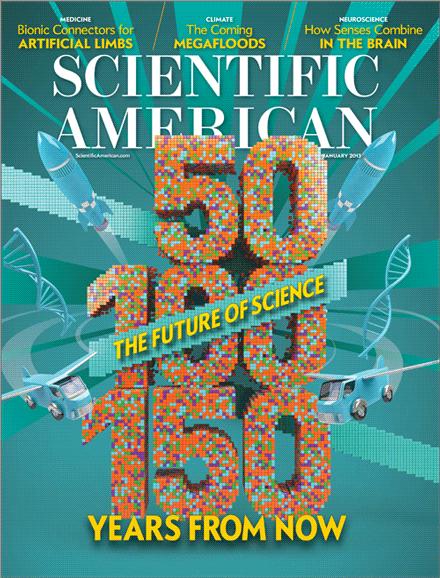

Universe Today
Space and astronomy news
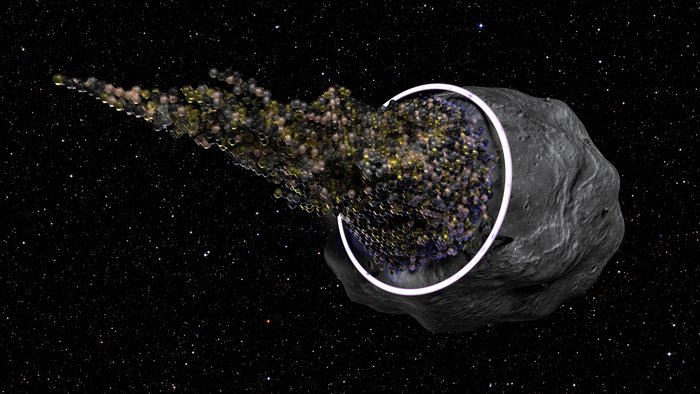
What’s the Minimum Number of People you Should Send in a Generational Ship to Proxima Centauri?
Humanity has long dreamed about sending humans to other planets, even before crewed spaceflight became a reality. And with the discovery of thousands of exoplanets in recent decades, particularly those that orbit within neighboring star systems (like Proxima b ), that dream seems closer than ever to becoming a reality. But of course, a lot of technical challenges need to be overcome before we can hope to mount such a mission.
In addition, a lot of questions need to be answered. For example, what kind of ship should we send to Proxima b or other nearby exoplanets? And how many people would we need to place aboard that ship? The latter question was the subject of a recent paper written by a team of French researchers who calculated the minimal number of people that would be needed in order to ensure that a healthy multi-generational crew could make the journey to Proxima b.
The study, titled “ Computing the minimal crew for a multi-generational space travel towards Proxima Centauri b “, recently appeared online and will soon be published in the Journal of the British Interplanetary Society . It was conducted by Dr. Frederic Marin, an astrophysicist from the Astronomical Observatory of Strasbourg , and Dr. Camille Beluffi, a particle physicist working with the scientific start-up Casc4de .
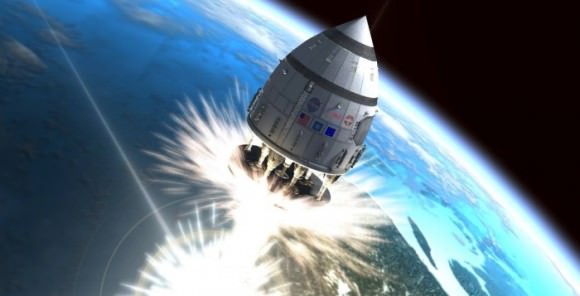
Their study was the second in a series of papers that attempt to evaluate the viability of an interstellar voyage to Proxima b. The first study, titled “ HERITAGE: a Monte Carlo code to evaluate the viability of interstellar travels using a multi-generational crew “, was also published in the August 2017 issue of the Journal of the British Interplanetary Society.
Dr. Marin and Dr. Beluffi begin their latest study by considering the various concepts that have been proposed for making an interstellar journey – many of which were explored in a previous UT article, “ How Long Would it Take to Get to the Nearest Star? “. These include the more traditional approaches, like Nuclear Pulse Propulsion (i.e. the Orion Project ) and fusion rockets (i.e. the Daedalus Project ), and also the more modern concept of Breakthrough Starshot .
However, such missions are still a long way off and/or do not involve crewed spaceflight (which is the case with Starshot). As such, Dr. Marin and Dr. Beluffi also took into account missions that will be launching in the coming years like NASA’s Parker Solar Probe . This probe will reach record-breaking orbital velocities of up to 724,205 km/h, which works out to about 200 km/s (or 0.067% of the speed of light). As Dr. Marin told Universe Today via email:
“This purely and entirely rely on the technology available at the time of the mission. If we would create a spacecraft right now, we could only reach about 200 km/s, which translates into 6300 years of travel. Of course technology is getting better with time and by the time a real interstellar project will be created, we can expect to have improved the duration by one order of magnitude, i.e. 630 years. This is speculative as technology as yet to be invented.”

With their baseline for speed and travel time established – 200 km/s-¹ and 6300 years – Dr. Marin and Dr. Beluffi then set out to determine the minimum number of people needed to ensure that a healthy crew arrived at Proxima b. To do this, the pair conducted a series of Monte Carlo simulations using a new code created by Dr. Marin himself. This mathematical technique takes into account chance events in decision-making to produce distributions of possible outcomes.
“We are using a new numerical software that I have created,” said Dr. Marin. “It is named HERITAGE, see the first paper of the series. It is a stochastic Monte Carlo code that accounts for all possible outcomes of space simulations by testing every randomized scenario for procreation, life, and death. By looping the simulation thousands of times, we get statistical values that are representative of real space travel for a multi-generational crew. The code accounts for as many biological factors as possible and is currently being developed to include more and more physics.”
These biological factors include things like the number of women vs. men, their respective ages, life expectancy, fertility rates, birth rates, and how long the crew would have to reproduce. It also took into account some extreme possibilities, which included accidents, disasters, catastrophic events, and the number of crew members likely to be affected by them.
They then averaged the results of these simulations over 100 interstellar journeys based on these various factors and different values to determine the size of the minimum crew. In the end, Dr. Marin and Dr. Beluffi concluded that under conservative conditions, a minimum of 98 crew members would be needed to sustain a multi-generational voyage to the nearest star system with a potentially habitable exoplanet.

Any less than that, and the likelihood of success would drop off considerably. For instance, with an initial crew of 32, their simulations indicated that the chances for success would reach 0%, largely because such a small community would make inbreeding inevitable. While this crew might eventually arrive at Proxima b, they would not be a genetically healthy crew, and therefore not a very good way to start a colony! As Dr. Marin explained:
“Our simulations allows us to predict with great precision the minimum size of the initial crew that will leave for centuries-long space travels. By allowing the crew to evolve under a list of adaptive social engineering principles (namely, yearly evaluations of the vessel population, offspring restrictions and breeding constraints), we show in this paper that it is possible to create and maintain a healthy population virtually indefinitely.”
While the technology and resources needed to make an interstellar voyage is still generations away, studies of this kind could be of profound significance for those missions – if and when they occur. Knowing in advance the likelihood that such a mission will succeed, and what will increase that likelihood to the point that success is virtually guaranteed, will also increase the likelihood that such missions are mounted.
This study and the one that preceded it are also significant in that they are the first to take into account key biological factors (like procreation) and how they will affect a multi-generational crew. As Dr. Marin concluded:
“Our project aims to provide realistic simulations of multi-generational space ships in order to prepare future space exploration, in a multidisciplinary project that utilizes the expertise of physicists, astronomers, anthropologists, rocket engineers, sociologists and many others. HERITAGE is the first ever dedicated Monte Carlo code to compute the probabilistic evolution of a kin-based crew aboard an interstellar ship, which allows one to explore whether a crew of a proposed size could survive for multiple generations without any artificial stocks of additional genetic material. “Determining the minimum size of the crew is an essential step in the preparation of any multi-generational mission, affecting the resources and budget required for such an endeavor but also with implications for sociological, ethical and political factors. Furthermore, these elements are essential in examining the creation of any self-sustaining colony – not only humans establishing planetary settlements, but also with more immediate impacts: for example, managing the genetic health of endangered species or resource allocation in restrictive environments.”

Dr. Marin was also quoted recently in an article in The Conversation about the goals of his and Dr. Beluffi’s project, which is all about determining what is needed to ensure the health and safety of future interstellar voyagers. As he said in the article:
“Of the 3757 exoplanets that have been detected, the closest Earth-like planet lies at 40 trillion kilometers from us. At 1% of the speed of light, which is far superior to the highest velocities achieved by state-of-the-art spacecraft, it would still take 422 years for ships to reach their destination. One of the immediate consequences of this is that interstellar voyages cannot be achieved within a human lifespan. “It requires a long-duration space mission, which necessitates finding a solution whereby the crew survive hundreds of years in deep space. This is the goal of our project: to establish the minimum size of a self-sustaining, long duration space mission, in terms of both hardware and population. By doing so, we intend to obtain scientifically-accurate estimates of the requirements for multi-generational interstellar travel, unlocking the future of human space exploration, migration and habitation.”
In the coming decades, next-generation telescopes are expected to discover thousands of more exoplanets. But more importantly, these high-resolution instruments are also expected to reveal things about exoplanets that will allow us to characterize them. These will include spectra from their atmospheres that will let scientists know with greater certainty if they are actually habitable.
With more candidates to choose from, we will be all the more prepared for the day when interstellar voyages can be launched. When that time comes, our scientists will be armed with the necessary information for ensuring that the people that arrive will be hail, hearty, and prepared to tackle the challenges of exploring a new world!
Further Reading: arXiv , arXiv (2) , The Conversation
Share this:
- Click to share on Facebook (Opens in new window)
- Click to share on Twitter (Opens in new window)
- Click to share on Reddit (Opens in new window)
10 Replies to “What’s the Minimum Number of People you Should Send in a Generational Ship to Proxima Centauri?”
So about 100. The same answer that’s been suggested for 50 years. I saw the title, and I knew the answer because that’s what I learned in grade school in the 70s.
And nothing has changed in the time since you were in grade school… ?
I too learned that in school 70s ….I think it was Mr. Gilbert”s glass.
The actual time would not be 6500 years since that is the time if the star stopped moving towards us.
The vector math should put you (unless I’m invited) there in just under 5,955 years, including the 11 hours you save due to Sp. Relativity. 🙂
I guessed 100 as well. This is about the largest size for hunter-gatherer communities and larger would get very expensive, I suspect.
And how many generations of humans will live and pass on before any such question is in need of answering, and what will be then be the technical abilities weighing on the question?
That makes attending this question now a futile exercise of scientists with too much time on their hands – hopefully not at taxpayers expense.
Some things haven’t changed since the 1960s, at least. In 1967-73 I ran a discussion project which led to my first book “Man and the Stars” (1974). The first half of the book was about colonising planets of other stars and the minimum group size needed was calculated by Patrick McNally, then a medical student, who went on to be a distinguished surgeon. Indeed, it came out to 100. Even at that, the big problem comes in the fifth or sixth generation, when only 4 or 5 people can be allowed to breed without passing on recessive characteristics which have now become apparent. If they’re still on the starship it might work, apart from the social problems, but in the rough-and-tumble of a colony on an unknown world there’s a huge risk that the key people would be lost to accidents or disease. Our conclusion was that the ‘foreseeable’ colony mission was unworkable, and the ‘acceptable’ one would require much larger ships and faster-than-light links with Earth. Some critics accused us of having abandoned science for science fiction at that stage. Indeed, in further discussions that led to “Man and the Planets” (1983), we decided to rule out life-bearing planets altogether for settlement and concentrate on gas giants, asteroid belts, and terraforming.
I’m guessing they are using male-female only pairing for procreation. I would think children by multiple partners would allow for a smaller crew and on landing faster population growth after settlement is established. Also, frozen eggs and or embryos could be used to add genetic diversity once settled at the destination.
I think if only females are sent along with frozen male sperms and only females are allowed to be born then crew size can be reduced dramatically.
Comments are closed.
Thank you for visiting nature.com. You are using a browser version with limited support for CSS. To obtain the best experience, we recommend you use a more up to date browser (or turn off compatibility mode in Internet Explorer). In the meantime, to ensure continued support, we are displaying the site without styles and JavaScript.
- View all journals
- My Account Login
- Explore content
- About the journal
- Publish with us
- Sign up for alerts
- Open access
- Published: 16 June 2020
Minimum Number of Settlers for Survival on Another Planet
- Jean-Marc Salotti 1 , 2 , 3
Scientific Reports volume 10 , Article number: 9700 ( 2020 ) Cite this article
53k Accesses
7 Citations
549 Altmetric
Metrics details
- Astronomy and planetary science
- Engineering
What is the feasibility of survival on another planet and being self-sustaining? This question is of particular importance for the future of the space conquest and perhaps also for the future of humanity in general [1,2]. The use of in situ resources and different social organizations have been proposed [3–6,12–19] but there is still a poor understanding of the problem’s variables. I show here that a mathematical model can be used to determine the minimum number of settlers and the way of life for survival on another planet, using Mars as the example [6,15]. It is based on the comparison between the time requirements to implement all kinds of human activities for long term survival and the available time of the settlers. An important parameter of the model is called the sharing factor, which allows some reduction of time requirements per individual if, for example, the activity concerns the construction of an object that can be shared by several individuals. For survival on Mars, some assumptions are made for the organization of the settlers and engineering issues [13–15]. The minimum number of settlers has been calculated and the result is 110 individuals. Other assumptions can be made. The proposed method allows assessments and comparisons, opening the debate for the best strategy for survival. If this relatively low number is confirmed, survival on another planet might be easier than expected, provided that the organization of the settlers is appropriate.
Similar content being viewed by others

Sustained and comparative habitability beyond Earth
Charles S. Cockell, Mark Simons, … Steven D. Vance

Search strategy in a complex and dynamic environment: the MH370 case
Stefan Ivić, Bojan Crnković, … Igor Mezić
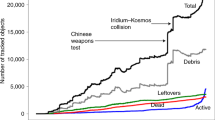
The case for space environmentalism
Andy Lawrence, Meredith L. Rawls, … Mark McCaughrean
Introduction
Humanity could be threatened with extinction due to some cataclysmic event 1 . As pointed out by Sagan, in this case, the only possible way to avoid the end of the world as we know it might be to settle another planet within a short period of time 2 . But what is the feasibility of survival on another planet for a small group of humans? The problem has already been addressed in terms of sufficient genetic diversity and social adaptation by several authors 3 , 4 , 5 , 6 , 7 . Marin and Beluffi showed that earlier studies were too constrained 6 . They performed simulations with different multi-generational population sizes and determined on a statistical basis that the group of humans could reasonably survive if the initial size were to be greater than 98. However, the problem has not been addressed in terms of engineering capacities and human resources for long-term survival.
Considering time and payload constraints, the number of people that could be sent to another planet would be rather limited. Space X is currently working on a giant reusable interplanetary vehicle with the objective of sending 100 persons at a time to the red planet. However, this is an optimistic estimate of the capability, the feasibility of the reusability remains uncertain and the qualification of the vehicle for landing on Mars and relaunch from Mars could be very difficult and take several decades. In most well studied mission to Mars scenarios, which last at least 6 months for the outbound trip and for crews of 3 to 6 astronauts, it is suggested to use several giant rockets to carry only a few dozens of tons of consumables to the red planet 8 , 9 , 10 , 11 . While on the planet, many authors proposed a settlement process based on the utilization of resources that can be found in the atmosphere or in the soil of the planet 12 , 13 , 14 , 15 . For instance, Zubrin proposed to extract carbon dioxide from the Martian atmosphere and water ice from the soil to produce oxygen and organic compounds, hematite to produce iron, silicates to produce glass, etc. 13 . Even if the feasibility of the approach is generally acknowledged, the complexity of the implementation is poorly understood and the number of items that would remain to be sent each year would still represent a tremendous challenge. From a practical point of view, it is not clear how many years it would take, as a minimum, to achieve a reasonable level of self-sufficiency, how many rockets would be required to send resources and goods and what would be the way of life and the organization of the society during the development period. If a slow settlement process is already a great challenge, what if time and payloads were constrained and the objective was the long term survival of the group without help from Earthlings?
Similar issues arise for interstellar travel. In the pioneering works from O’Neill, Bond and Martin, or Matlof, the long term survival of a small group of humans has been addressed 16 , 17 , 18 . Engineering and human factor issues were highlighted, especially the reliability of systems, knowledge management and psychology but the feasibility remained uncertain and not well understood. An important question, which is addressed in this paper, is to determine the minimum number of individuals in terms of human resources and the most appropriate organization to survive on an extra-terrestrial world, which might eventually be artificial. In a more recent paper, Hein et al . revisited the issue of world ships for interstellar travel 19 . Interestingly, the last words of their conclusion were: “All issues related to determining an adequate crew size will have a major impact on the feasibility of a world ship”. It should be noticed that this question is also of interest if the objective is to settle on a given planet according to a slow and well-established plan. Indeed, there exist many possible dramatic reasons that may cause the failure of such a plan. Suppose for instance that a settlement has already started and that there are regular space trips towards the planet. In case of war on Earth, important space sector infrastructures may be destroyed, causing a long term interruption in space travel. It could also happen that a conflict occurs between the terrestrial governments and the settlers and, later on, a group declares independence and tries to survive on its own. Another reason could be the will of a new government to stop the settlement process because of the never-ending increasing cost.
For all these reasons, the problem of determining the minimum number of individuals for survival is of interest. It is possible to make assumptions and to discuss different scenarios but what is generally lacking is a methodology to perform quantitative assessments, especially for engineering issues. The objective of the paper is to show that mathematical modelling of the problem is possible. In next paragraphs, a mathematical expression is proposed and the parameters are discussed. A case study is also presented concerning survival on Mars. Some assumptions are made and the minimum number of individuals to survive on Mars is determined.
Mathematical Model
Main principles.
The problem can be mathematically defined in different ways. Basically, regarding human resources, the minimum number of individuals for survival depends on their capacity to produce essential objects and consumables using local resources. The initial state of the settlement is very important because large quantities of resources and modern tools may help a lot in developing industries and achieving a viable state. However, there are two reasons suggesting that the impact of the initial state is not so important. On the one hand, a limiting factor is the cost and complexity of interplanetary trips. On the other hand, the lifetime of modern tools such as vehicles, computers, robots, etc. is in general in the order of ten years, which is very short and implies finding quickly solutions to replace them. For the sake of simplicity, it is assumed here that the initial amount of resources and tools sent from Earth will be rather limited and as a consequence will not have much impact on survival. Providing that the initial state is viable, it is assumed that survival depends only on two important variables:
Available local resources. A local resource can be a gas, mineral or liquid present on the surface of the planet. It is available if its exploitation is possible to extract useful chemical elements. Specific chemical elements have to be found on the planet for survival (water, oxygen, etc.). They must exist as available local resources or they have to be produced from the exploitation of other local resources.
Production capacity. The production capacity is defined by the number of items (consumables, tools, …) that can be produced among the list of all items needed for survival for a given period of time. For a given number of settlers, the capacity has to reach an acceptable threshold allowing survival and development of the settlement.
Logically speaking, from an engineering standpoint, survival can be simply expressed as follows (1):
requirements and capacities can only be compared for a given period of time. It is proposed here to consider the orbital period of the planet (OP) as the reference time for comparisons. As many objects have a longer lifetime (life support systems, habitation, etc.) the time for their maintenance, repair or reconstruction has to be taken into account using a proportion of the OP. If it is possible to find appropriate resources on the planet, the working time requirements and the working time capacity depend on:
The number of settlers.
What living conditions are acceptable.
The main engineering choices for agriculture, industry and life support.
The sharing and organization of the settlement.
As the number of people grows, the needs for survival also grow. Nevertheless, as some objects can be shared among several individuals (e.g., a habitat or a vehicle), the working time requirements grow slower than the working time capacity. It is therefore expected that, above a minimum number of individuals, the constraint is satisfied and survival becomes possible.
Working time capacity
The right hand part of the expression is the working time capacity. “working” is defined here in the broad sense, excluding sleeping, eating, hygiene and resting, but including activities such as raising babies, preparing meals and social activities, which are required for mental health and cohesion of the group. An estimation can easily be provided. The cumulated annual living time is given by the orbital period times the number of individuals. Part of this time is used for sleeping (one third), or for eating, hygiene, and resting (one twelfth). In addition, children and elderly persons are less productive. About one fourth of the population is assumed unproductive. All in all, the annual working time capacity is estimated at 31.25% of the annual living time. See methods for the details.
Working time requirements
The annual working time requirements can be estimated by determining the set of all essential human activities required for survival. Obviously, in order to fulfil fundamental needs such as breathing, eating, or raising children, various industrial processes have to be implemented. For instance, the construction of a new building might require extracting specific ores and the use of tools made of iron, which implies an iron industry. For survival with a short number of individuals, the working time requirements have to be minimized. As a consequence, it is necessary to minimize the number of industries and at the same time to maximize productivity using modern tools. A trade-off must therefore be found between the productivity rate and the small size of the industrial development. As a first approach to the problem, a possible approach is to split human activities into 5 domains, as illustrated Fig. 1 :
d 1 : In the domain of ecosystem management , the main activities are designing and maintaining systems for the production of appropriate gases, controlling air composition, pressure and temperature in habitable modules, collecting, producing and recycling water, controlling life cycles of all living organisms, processing organic wastes, growing plants for agriculture and finally producing and storing food.
d 2 : In the domain of energy production , depending on the strategy, for instance if it is decided to use photovoltaic cells to produce electricity and to produce methane for vehicles, the main activities are linked to the extraction and processing of silicates, producing photovoltaic cells, wires, and extracting methane thanks to a Sabatier reactor. Heating also belongs in this category.
d 3 : In the domain of industry , especially metallurgy and chemistry, the main activities are extracting, collecting and processing appropriate ores, making construction materials, manufacturing objects, and producing tools for other activities (e.g., agriculture). Industry may also be concerned in the production of glass, ceramics and plastics, as well as clothes and medicine depending on the strategic choices for survival.
d 4 : Building domain. Even if a base is built before the arrival of humans, it will have to be frequently reorganized according to the evolution of the settlement (number of settlers, new industries, new organization of the work, new way of life, etc.). In addition, the lifetime of any construction is limited. New habitable zones with new ecosystems and new factories will have to be built close to interesting local resources. Everything will have to be designed and organized for good living conditions and optimization of the work. All activities linked to the architecture, organization (or reorganization), maintenance and construction of buildings are included here.
d 5 : The last domain concerns social activities . For survival and for the development of the settlement (without development, a small settlement could easily collapse), it is important to raise children and to educate them. It is therefore assumed that the growing rate of the population is positive. Other fundamental human activities concern health care, preparing meals, cleaning, washing, organizing the work and making decisions. For survival, time for sport, culture and entertainment can be minimized, but probably not totally eliminated.
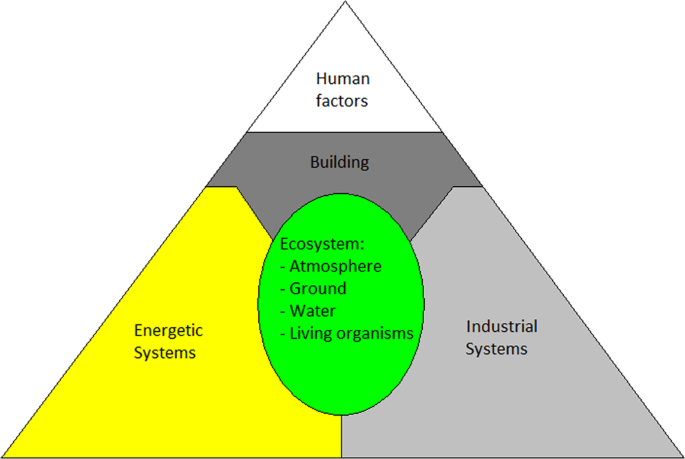
For survival, 5 important domains are highlighted.
Importantly, for each activity, some margins must be taken into account to cope with unforeseen events. Other activities must concern adaptations of processes to the size of the population and time for reorganization and industrial mutations.
Sharing factor
As the number of individuals grows in the settlement, more and more objects are shared among them. For instance, people can live in the same habitat, sharing the same air revitalization system, the same water processing system, the same energy production system, etc. If each settler was completely isolated and no sharing was possible, each individual would have to perform all activities and the total time requirement would be obtained by a multiplication by the number of individuals. In addition, a greater number of individuals makes it possible to be more efficient through specialization and to implement other industries allowing the use of more efficient tools. In order to take the possibility of sharing and productivity into account, a sharing factor can be introduced. The time requirement for a given single activity can be simply divided by this factor, which would be different for each activity and for each number of individuals. The sharing factor can be estimated by different functions (polynomial, trigonometric, step functions, etc.). In a restricted range, it can be conveniently estimated by Eq. ( 2 ). See Methods for a detailed analysis of the sharing factor.
\({a}_{i}\) : activity i
n: number of settlers
\(s({a}_{i},n)\) : sharing factor for activity i with n the number of settlers
\({\propto }_{i}\) : constant associated to activity i
Remark: The sharing factor depends on the needs, the processes, the resources and environmental conditions, which may be different depending on the planet.
Mathematical expression
A mathematical expression of constraint (1) can now be obtained. As the total working time capacity is linearly correlated with the number of individuals and the way of calculating the total time requirement for all activities is also a factor of n, n can be eliminated in both sides of the equation.
The survival of the settlers can finally be determined by Eq. ( 3 ).
\(r({a}_{j,i})\) is the individual annual working time requirement to run activity i in domain \({{\boldsymbol{d}}}_{{\boldsymbol{j}}}\) .
\(s({a}_{j,i},n)\) is the sharing factor for activity \({{\boldsymbol{a}}}_{{\boldsymbol{j}},{\boldsymbol{i}}}\) with n the number of individuals.
k 1 to k 5 are the number of activities for domains \({{\boldsymbol{d}}}_{1}\,\) to \({{\boldsymbol{d}}}_{5}\) .
The individual annual working time requirement can be estimated for each activity. Sharing factors are thus the only parameters defined as functions of n (Eq. ( 2 )). The minimum number of settlers for survival is therefore the minimum value of n for which constraint (3) is respected.
Risks issues
Even if there are enough individuals for the production of goods, a small society can collapse for many different reasons. According to Marin and Beluffi, these reasons can be infertility, inbreeding, sudden deaths (genetic issues included 7 ), accidents or random events 6 . Other important risks with severe impacts concern the loss of important assets, the loss of large amounts of resources, mortal fights among different groups of individuals, or a significant loss of efficiency at work due to inappropriate social organization (e.g., loss of know-how, loss of motivation, bureaucracy, etc.). In order to mitigate the risks, a possible option is to produce more than the minimum. This is especially true at the beginning of the settlement, as any accident could dramatically reduce the production capacity. In the early stages, the severity of the risks also depends on the initial state. In order to mitigate the risks, it will therefore be important to start with large amounts of resources and spare parts. Complementary studies are needed using simulations with different parameters to assess the probability of success for the proposed minimum number of settlers.
Case Study: Survival on Mars
The method is applied to the survival on Mars. The objective is to determine the minimum number of individuals that is compatible with constraint (3). The difficulty is to determine the best trade-off among the different parameters, especially the types of resources that will be exploited, the industries that will be implemented, the organization of the work, the way of life, etc. The specific utilization of Martian resources for life support, agriculture and industrial production has been studied in different workshops and published in reports and books 12 , 13 , 14 , 15 . As the complexity of the problem is high, the viability and optimality of any set of choices will remain uncertain. In a recent contest organized by the Mars Society, people were asked to define a realistic scenario to settle the red planet. As our proposal was based on conservative assumptions and the ability to survive if the help from Earthlings were stopped, it is proposed here to use it as a guideline 15 . See Methods for more details about our hypotheses.
The total working time requirement per individual to implement each activity has been calculated as a function of the number of individuals. According to Eq. ( 3 ), survival is possible only if the working time requirement is less than the working time capacity. As the working time requirement per individual is decreasing with the number of individuals (thanks to sharing factors), the determination of the minimum number of individuals for survival is straightforward. The result is presented Fig. 2 . The minimum number of individuals for survival on Mars is 110.
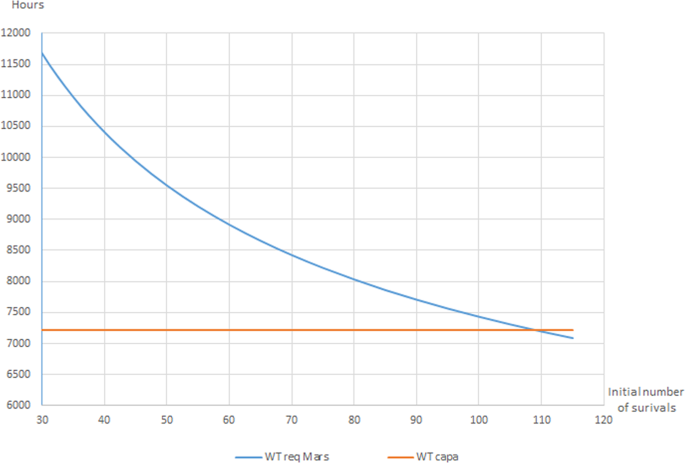
Determination of the minimum number of individuals for survival on Mars. The annual working time capacity is greater than the annual working time requirement if the initial number of individuals is greater than 110.
Another interesting result is the distribution of the working time requirement for one individual in comparison with the individual time requirement for 110 individuals (see Fig. 3 ). For a single person, the problem is to implement all industrial activities, while for 110 persons, half of the working time requirement is in the domain of social activities, including raising babies, health care and cultural events.

Working time requirement distribution for 1 (left) and 110 individuals (right).
An original method has been proposed to determine the minimum number of individuals for survival on another planet or in space, using Mars as the example. It is based on the comparison between the required working time to fulfil all the needs for survival and the working time capacity of the individuals. An important parameter of the model is the sharing factor, which is used to take sharing and productivity into account. In the example provided to illustrate the method, the estimated minimum number of individuals for survival on Mars is 110. This is obviously a rough estimate with numerous assumptions and uncertainties. To our knowledge, it is nevertheless the first quantitative assessment of the minimum number of individuals for survival based on engineering constraints. Other assumptions can be made. It is also possible to consider the case of survival on the Moon, with different industrial processes, different energy systems, difference life support systems etc. and to compare the results with survival on Mars. Noticeably, as Moon nights last about 14 days, growing plants might require full artificial lighting, which in turn would have a tremendous impact on energy requirements, suggesting that more human resources would be needed for that domain. 110 individuals could thus be insufficient for survival on the Moon but a more detailed study is needed before drawing any conclusion. Our method allows simple comparisons, opening the debate for the best strategy for survival and the best place to succeed.
Annual working time capacity
The annual living time depends on the orbital period of the planet. It is 8,766 hours on Earth and 16, 487 hours on Mars (686.97 × 24). According to the National Sleep Foundation, adults are sleeping 7 to 9 hours on average, which represent about 33% of the living time. On another planet, with a different rotation period, the sleeping time could be different. As no data is available for that, it is assumed here that the sleeping time remains 33% of the living time. Part of the living time also has to be spent for eating and another part for hygiene. In total, on Earth, it can be assumed that approximately 10 hours out of 24 are dedicated to these activities, sleeping included, which represent 41.7% of the living time. Even if the duration of the day is longer or shorter, the same ratio is assumed in first approximation. The presence of children, elderly persons and eventually handicapped persons will reduce the working time capacity. The impact highly depends on the age pyramid. The best strategy for the proportion of children and the shape of the age pyramid at the beginning of the survival time is hard to define. In agreement with the study from Marin and Belufi, it is assumed that the age pyramid must be rather homogeneous to avoid future gaps in productive age classes and too many individuals in the young or elderly age 6 . As a consequence, the number of children in the age range 0 to 10 should be stabilized around 20% of the total. At the age of approximately 10, even if they still need education, children can help adults in many ways and become productive. As a first approximation, the unproductive 20% and the reduction of the productivity for young adults and elderly persons can be taken into account in the working time capacity by removing 25% of the individuals in the total working time capacity. The annual working time capacity is thus estimated at 31.25% of the annual living time (41.7 × 0.75) times the number of individuals. It is important to notice that the specific time required for raising and educating children also has to be estimated but this is accounted for in the working time requirements.
Sharing factor estimation
The settlers can share the same air revitalization system, the same water processing system, the same habitat, etc. Obviously, the scale of the systems has to be adapted to the number of individuals, but scaling up has often a small impact on the required time to develop and operate the systems. In addition, time savings are expected for a greater number of individuals thanks to specialization and productivity gains. For some activities, however, scaling up does not provide substantial time savings. For instance, the required time for picking fruits on plants is closely correlated with the amount of fruits to be collected, which is linearly correlated to the number of individuals. An important issue is to be able to calculate the sharing factor as a function of the number of individuals. If such a function were available, the minimum number of settlers for survival could be deducted from Eq. ( 3 ). Importantly, whatever the activity, the sharing factor is equal to 1 for 1 individual and then increases with the number of individuals according to a curve that follows, as a first approximation and in most cases, a logarithmic law (in a way similar to productivity gains). Such curves can be conveniently approximated by Eq. ( 2 ) with \(\propto \) in the range [0;1].
Sometimes, this depends on the organization of the society. Imagine for instance that the settlement is split into groups of a hundred individuals with autonomous life support and energy systems. In this case, the sharing factor of activities linked to life support or energy would resemble a step function, with a monotonic growing rate below 100 and a division by a factor of 2 when 101 is reached, then another monotonic rate, etc. The most appropriate function must be used if it is known. For the sake of simplicity, and in the context of this preliminary study, it is suggested here to use Eq. ( 2 ) to estimate the sharing factor of most activities. In order to determine \({\propto }_{i}\) the proposed method is to interpolate the function with two points. The first point is given with n=1 by \({1}^{{\propto }_{i}}=1\) and the second point is given by an estimation of the sharing factor for 100 individuals. Then \({\propto }_{i}\) is chosen such that \({100}^{{\propto }_{i}}\) is a good approximation of that value.
Noticeably, if the activity is completely modified for a greater number of individuals due to adaptations of technologies and procedures, it is possible to take changes into account by an appropriate modification of the sharing factor.
Let us illustrate this method with 2 examples:
The same oxygen production unit (based on water electrolysis) can be shared by all individuals of the same habitable area. The scale of that unit must be adapted to the production needs, but the sharing factor quickly increases with the number of individuals. At some point, however, other oxygen production units must be built for other habitable areas. The sharing is not increasing any more, but there is an industrial development allowing the use of better materials and more efficient processes. For large values of n, productivity gains are therefore expected and the sharing factor can still be used to take these gains into account. For 100 individuals, the sharing factor is estimated at 25. For oxygen production and n individuals, a good estimate is thus provided by \({n}^{0.7}\) .
For the construction of a new habitat, 10 individuals specialized in an activity may work 20 times faster than a single person doing everything. For 10 individuals, the total working time would therefore be divided by a sharing factor of 2. Now, in order to divide the working time by another factor of 2, the number of individuals might have to exceed 100. In this case, \({n}^{0.3}\,\) would be a good approximation of the sharing factor.
Main hypotheses for survival on Mars
Our proposal is based on a previous study, which aimed at defining the best way to implement a Martian settlement 15 . The survival capability, which was considered essential, was based on three important principles:
Make it simple : In the initial state, all individuals will live under a dome and will share the same life support system pressurized at 350 mb with 80% oxygen. Plants will be grown in numerous greenhouses made of glass maintained in an iron based structure with reflectors behind to provide sufficient light. In order to create an appropriate soil for plants, it will be necessary to make a mixed of rocks, salts, water and to add also organic wastes and decomposers (insects and microorganisms). Water will be extracted from icy terrain and recycled using natural filters. The idea is to minimize the need for complex objects. There will be no LED for artificial lighting, there will be no complex chemistry for hydroponic cultures and water will be filtered without artificial systems. For energy, however, it is not possible to avoid artificial systems. Photovoltaic cells will provide electricity, biomass (methane) will be used to power engines and solar furnaces will be used to heat up materials. Though rather limited, several important industries will have to be implemented to produce iron based objects (including simple vehicles), clothes (there must exist a way to make a space suit from available local resources), glass, ceramics, duricrete (concrete like material) and photovoltaic cells. An important issue is to determine if modern tools are necessary for survival on Mars and if global productivity gains enabled by computers, robots and other modern tools, are greater than the additional time requirements for their production and maintenance. The production of photovoltaic cells and spacesuits, for examples, will certainly be difficult technical challenges if no modern tool is used. It is nevertheless assumed here that such challenges can be faced and that all activities for survival are possible without computers and robots. For radiation shielding, it is generally recommended to add a few meters of regolith above the habitat to reduce radiation levels below acceptable limits (on Earth, it is 100 REM in 5 years) 13 , 14 . However, above official limits, the probability of dying from cancer due to radiations is slowly increasing. Full shielding is a possible option, but survivors might choose a tradeoff between no shielding and full shielding in order to get good living conditions (sunny lighting with transparent windows) perhaps at the expense of 3 to 5 years of average life expectancy.
Maximize sharing : The group of survivors can share the dome’s ecosystem - air, water, food, energy - and also recycling systems - tools, spacesuits, vehicles, industries, etc.
Develop step by step : For short term survival, it is possible to accept harsh living conditions, but it is not acceptable in the long term. The evolution of the settlement can be made possible by first accumulating resources (human resources, ores, wood, iron, backup food, backup tools, etc.) and then creating a new base elsewhere with volunteers. The accumulation of resources will compensate for the temporary lack of human resources. Then for each new base, efforts can be concentrated on the development of new industries in order to achieve a modern society step by step, after centuries of development.
See 15 for more details about the settlement strategy. The list of human activities required for survival can be deduced from the proposed strategy in each of the five domains that have been identified and are illustrated Fig. 1 . The time requirement and sharing factor for each activity can then be estimated as a function of n, defined as the number of individuals.
Estimation of time requirements for survival on Mars
The main activities and their time requirements are listed Tables 1 , 2 , 3 , 4 and 5 for ecosystem management, energy production, industry production, building construction, and social activities, respectively. For each activity, the annual working time requirement per individual has been estimated with associated range for 95% confidence interval (heuristically determined), as well as the sharing factor according to the number of individuals, taking sharing and productivity gains into account.
Ecosystem management: Agriculture is probably the activity that requires more time than the others when the size of the group is high. The reason is because the needs (kilograms of vegetables, fruit, etc.) will increase linearly with the number of individuals and the sharing factor is therefore relatively weak and linked only to productivity gains. Water management takes a lot of time, but the same system can be shared by many people, which means that the sharing factor is very high. See Table 1 .
Energy domain: Photovoltaic cells will not have to be produced all the time, but as they will have to be changed after about fifteen years, the average annual production rate will not be negligible. For electricity, some electronic devices and wires will have to be produced. For such activities, it is assumed that industrial assets will provide basic elements such as iron, silicon, copper, plastics, etc., or appropriate substitutes. Even if energy consumption is highly correlated with the number of individuals, a large part of that energy will be used to produce objects that will be shared (for instance vehicles, tools, industrial ovens, etc.). It is therefore assumed that the sharing factor is quickly increasing with n. See Table 2 .
Industrial domain: Rich metallic ores may be hard to find on Mars. However, even if extraction is not as efficient as it is on Earth, some resources can easily be exploited. Hematite is for example present and can be processed to obtain ferrous elements. Silicates can also be found in the sand of dunes. Producing glass and photovoltaic cells from it will not be easy, but it is feasible. Eventually, a trade-off can be found between purity and complexity of chemical processes. A lot of time is allocated to industrial activities, from mining to metal production and object manufacturing. Numerous objects will indeed be used in other domains, for instance pumps for agriculture, wires for electricity, tools for mining, metallic structures to support the walls of buildings, textiles for space suits, etc. The positive point is that a lot of time can be saved when n increases by sharing and also by means of productivity gains.
Building domain: Even if it is assumed that a base has been built prior to the arrival of the survivals group, many systems will require regular maintenance and, after two or three decades, the walls, the roof and the structure of the base may suffer from cracks and degradation. For long term survival, it is imperative for the group to be able to build new bases, including greenhouses, habitats, small factories, etc. The average annual working time may not be high, and many buildings can be shared, but it is not negligible.
Social activities: Let us consider first raising babies and young children. This activity involves many different elementary activities such as feeding, washing, dressing, watching, etc. As the babies’ ratio must be constant, as a first approximation, feeding them requires a time that is linearly correlated with the number of settlers. For this activity, the sharing factor would therefore be close to 1 (no sharing). However, watching babies and young children while they are playing or sleeping could be carried out in parallel with a constant ratio of 1 person for 20 of them (certainly less when they are very young and more when they are getting older). The sharing factor would thus be equal to 20 at the maximum, for large values of n. On average, taking all elementary activities for raising babies into account, it is assumed that the sharing factor slowly increases towards 8, which would be an asymptotic maximum. If we set SF(1) = 1 and SF(100) = 4, n 0.3 would be a good approximation of the sharing factor for small values of n but not for large values. A trade-off is proposed: if n < 1024 SF(n) = n 0.3 otherwise SF(n) = 8. Apart from raising children and education, many other activities fall into this domain. First, health care, including teeth washing, hand washing, haircuts, etc. has to be taken into account. The preparation of meals also takes some time. It is assumed here that the group will share such preparation to save time. Another important issue is to take cultural events, sports and entertainment into account. For short term survival, it is possible to work every hour of the day during dozens of days, but for the long term, it does not sound a reasonable assumption. It is assumed here that one twelfth of the living time will be dedicated to these unproductive but necessary activities to strengthen the mental health of each individual and social cohesion. Finally, it is also important to consider some time for the organization of the group, especially talking about problems, decision making, reorganization of the work, and also for possible innovations, which will probably be necessary and fairly frequent.
All values are integrated in Eq. ( 3 ). Then, the total annual time requirement is calculated as a function of n. The minimum value of n for which the total time requirement is below the threshold (working time capacity) is the minimum number of individuals for survival.
Bostrom, N., Existential Risks Analyzing Human Extinction Scenarios and Related Hazards, Journal of Evolution and Technology 9 (1), (2002).
Sagan, C. Pale Blue Dot: A Vision of the Human Future in Space (1994).
Moore, J. H. Kin-based crews for interstellar multi-generational space travel, in: K. Yoji, F. Bruhweiler, J. Moore, C. Sheffield (Eds.), Interstellar Travel and Multi-Generation Space Ships, Collectors Guide Publishing, Burlington, Ontario, Canada, 80–88 (2003).
Smith, C. M. Estimation of a genetically viable population for multigenerational interstellar voyaging: Review and data for project Hyperion. Acta Astronautica 97 , 16–29 (2014).
Article ADS Google Scholar
Smith, C. M., An Adaptive Paradigm for Human Space Settlement, Acta Astronautica 119 , (November 2015).
Marin, F. & Beluffi, C. Computing the minimal crew for a multi-generational space journey towards Proxima Centauri b. Journal of the British Interplanetary Society (JBIS) 71 , 431–438 (2018).
Google Scholar
Lynch, M., Conery, J., Reinhard0, B., Mutational Meltdowns in Sexual Populations, Evolution 49 (6), 1067–1080 (1995).
Drake, G., ed., Mars Architecture Steering Group, 1 st Addendum of the Human Exploration of Mars, Design Reference Architecture 5.0, NASA Johnson Space Center (2009).
Drake, G. ed., Mars Architecture Steering Group, 2 nd Addendum of the Human Exploration of Mars, Design Reference Architecture 5.0, NASA Johnson Space Center (2014).
Genta, G. & Salotti, J.-M.(ed.), Global Human Mars System Missions Exploration, Goals, Requirements and Technologies, Cosmic Study of the International Academy of Astronautics , (January 2016).
Salotti, J.-M. Robust, affordable, semi-direct Mars mission, Acta Astronautica 127 , October–November, 235–248, (2016).
Johnson, R. D. & Holbrow, C., Space Settlements – A Design Study, NASA Scientific and Technical Information Office. SP-413 (1977).
Zubrin, R. & Wagner, R. The Case for Mars: The Plan to Settle the Red Planet and Why We Must, ISBN 978-0684835501 (2011).
Petrov, G. I., Mackenzie, B., Homnick, M. & Palai, J., A Permanent Settlement on Mars: The Architecture of the Mars Homestead Project”, proc. of the International Conference On Environmental Systems, Roma, Italy (July 2005).
Salotti, J.-M. Chapter 5: The Team ENSC Vizzavona Design, in Mars Colonies: Plans for Settling the Red Planet, Frank Crossman ed., Polaris Books, Lakewood, Colorado (2019).
O’Neill, G. K., The Colonization of Space, Physics Today 27 (9), 32–40, (September 1974).
Matloff, G. L. Utilization of O’Neill Model I Lagrange Point Colony as an Interstellar Ark. Journal of the British Interplanetary Society (JBIS) 29 , 775–785 (1976).
ADS Google Scholar
Bond, A. & Martin, A. R. World Ships – An Assessment of the Engineering Feasibility”. Journal of the British Interplanetary Society (JBIS) 37 , 254–266 (1984).
Hein, A. M., Pak, M., Pütz, D., Bühler, C. & Reiss, P. World Ships, Architectures & Feasibility Revisited”. Journal of the British Interplanetary Society (JBIS) 65 , 119–133 (2012).
Download references
Acknowledgements
The author would like to thank the researchers, engineers and the members of the International Academy of Astronautics who provided valuable remarks: Giancarlo Genta, Giuseppe Reibaldi, Maria Antonietta Perino, Robert Zubrin, Richard Heidmann and Association Planète Mars, and the students of the Ecole Nationale Supérieure de Cognitique, Bordeaux INP, France: Laetitia Calice, Caroline Cavel, Adrien Leduque and Mateo Mahaut.
Author information
Authors and affiliations.
Univ. Bordeaux, CNRS, Bordeaux INP, IMS, UMR 5218, F-33400, Talence, France
Jean-Marc Salotti
INRIA, IMS, UMR 5218, F-33400, Talence, France
Association Planète Mars, F-33400, Talence, France
You can also search for this author in PubMed Google Scholar
Corresponding author
Correspondence to Jean-Marc Salotti .
Ethics declarations
Competing interests.
I declare that I have no significant competing financial, professional, or personal interests that might have influenced the performance or presentation of the work described in this manuscript.
Additional information
Publisher’s note Springer Nature remains neutral with regard to jurisdictional claims in published maps and institutional affiliations.
Rights and permissions
Open Access This article is licensed under a Creative Commons Attribution 4.0 International License, which permits use, sharing, adaptation, distribution and reproduction in any medium or format, as long as you give appropriate credit to the original author(s) and the source, provide a link to the Creative Commons license, and indicate if changes were made. The images or other third party material in this article are included in the article’s Creative Commons license, unless indicated otherwise in a credit line to the material. If material is not included in the article’s Creative Commons license and your intended use is not permitted by statutory regulation or exceeds the permitted use, you will need to obtain permission directly from the copyright holder. To view a copy of this license, visit http://creativecommons.org/licenses/by/4.0/ .
Reprints and permissions
About this article
Cite this article.
Salotti, JM. Minimum Number of Settlers for Survival on Another Planet. Sci Rep 10 , 9700 (2020). https://doi.org/10.1038/s41598-020-66740-0
Download citation
Received : 11 December 2019
Accepted : 26 May 2020
Published : 16 June 2020
DOI : https://doi.org/10.1038/s41598-020-66740-0
Share this article
Anyone you share the following link with will be able to read this content:
Sorry, a shareable link is not currently available for this article.
Provided by the Springer Nature SharedIt content-sharing initiative
By submitting a comment you agree to abide by our Terms and Community Guidelines . If you find something abusive or that does not comply with our terms or guidelines please flag it as inappropriate.
Quick links
- Explore articles by subject
- Guide to authors
- Editorial policies
Sign up for the Nature Briefing newsletter — what matters in science, free to your inbox daily.
Advertisement
"Magic number" for space pioneers calculated
By Damian Carrington
15 February 2002
The “magic number” of people needed to create a viable population for multi-generational space travel has been calculated by researchers. It is about the size of a small village – 160. But with some social engineering it might even be possible to halve this to 80.
Anthropologist John Moore from University of Florida tackled the problem as part of a combined effort with space scientists to determine how in future humans might successfully undertake century-long journeys out into space.
Discover more about NASA’s missions: Explore four NASA space centres on a New Scientist Discovery tour
In the past, attention has been focused on cryogenics, sperm banks and military-style modes of operation, says Moore, but “the ‘right stuff’ for a journey into space is the family – a million-year-old institution designed to assist reproduction.”
Moore has previously studied small migrating populations of early humans and has developed simulation software – called Ethnopop – for analysing the viability of small groups.
Marriage partners
For a space trip of 200 years, perhaps eight to 10 generations, his calculations suggest a minimum number of 160 people are needed to maintain a stable population.
This would produce around 10 potential marriage partners per person, he says, and if this seems a small number, “think about how many people you dated before you got married”.
Room would be at a premium on any spacecraft and reducing the number of people initially required might be desirable. Moore suggests two strategies. The first is to begin with young childless couples, echoing the practice of Polynesian seafaring colonists.
The second is to ask the space crew to postpone reproduction to later in woman’s fertile period, perhaps age 35 to 40, creating longer time gaps between the generations. This measure results in a stable population of just 80 but the consequences of the increased medical risks of late childbirth have not yet been considered.
A potential concern is that small populations can suffer a damaging reduction in genetic diversity due to inbreeding, says Dennis O’Rourke from the University of Utah. He considered the same 10-generation, 200-year journey as Moore and looked at both genetic drift and inbreeding.
“The decrease in genetic variation is actually quite small and less than found in some successful small populations on Earth,” he says. “It would not be a significant factor as long as the space travellers come home or interact with other humans at the end of the 200 year period.”
Gene screening
O’Rourke believes that a more serious concern would be the presence of potentially damaging genotypes in the initial space pioneers. Genetic screening might well be needed, he says: “Any harmful recessive characteristics might lead to increased healthcare loads which would deplete scarce resources.”
A final concern raised at the American Association for the Advancement of Science’s annual meeting in Boston was the possibility of infighting. Small communities isolated for long periods at research stations in Antarctic and even families travelling on long car journeys, provide examples of how small conflicts can quickly escalate.
But Moore points out: “Some small island communities on Earth have lived in peace and harmony for thousands of years because they have developed ways of solving conflicts. These are not taken to Antarctica.”
Sign up to our weekly newsletter
Receive a weekly dose of discovery in your inbox! We'll also keep you up to date with New Scientist events and special offers.
More from New Scientist
Explore the latest news, articles and features
Ancient Maya burned their dead rulers to mark a new dynasty
Environment, what is cloud seeding and did it cause the floods in dubai, ancient marine reptile found on uk beach may be the largest ever, ancient humans lived inside a lava tube in the arabian desert, popular articles.
Trending New Scientist articles
The Best Sci Fi Books
Find a great science fiction book, 19 best generation ship books.

Take a bunch of humans, put them in a large but limited space and keep them there for generations. Watch the chaos ensue.
Of course, you can also take the perspective that our entire planet is a generation ship.

Centuries ago, the Star Folk left Earth on twelve spaceships on a generations-long mission to colonize the distant stars. Ten of the ships had reached their destinations, but two failed, and nobody, in the hundreds of years since the disaster, had the slightest inkling of what had happened.
Joneny, a student of galactic anthropology, was given the problem of the missing ships as a now-boring assignment. He discovered two wrecked ships, but he was ill prepared for what he found. One ship, the Sigma-9 , was not subject to the laws of time-stasis (the only exception to a universal law), and it was covered entirely with a mysterious green fire. Joneny also discovers recordings from the passengers, which spell out the tragic history of the ships.

This Nebula Award-winning book takes place in 2198, one hundred and fifty years after the desperate wars that destroyed an overpopulated Earth. Humans now live on a hundred hastily-established colony worlds and inside the seven giant Ships that once ferried people to the stars. Young Mia Havero’s Ship is a small closed society that tests its children by casting them out to live or die in a month of Trial in the hostile wilds of a colony world. Mia Havero’s Trial is fast approaching, and in the meantime she must learn not only the skills that will keep her alive but the deeper courage to face herself and her world.

On the alien, sunless planet called Eden, the 532 members of the Family take shelter beneath the light and warmth of the Forest’s lantern trees. Beyond the Forest lie the mountains of the Snowy Dark and a cold so bitter and a night so profound that no one has ever crossed it.
The Oldest among the Family recount legends of a world where light came from the sky, where men and women made boats that could cross the stars. These ships brought us here, the Oldest say—and the Family must only wait for the travelers to return.
But young John Redlantern will break the laws of Eden, shatter the Family, and change history. He will abandon the old ways, venture into the Dark, and discover the truth about their world.
“A stunning novel and a beautiful evocation of a truly alien world.” —Sunday Times (UK)

Far from Earth, on a ship carrying the 13th and 14th generations of descendants from the original crew, life is short. You are born, learn the tasks needed to keep the ship running, help breed and train the next crew, and your death is ordered by the computer in charge. Gregson, chief of the psych-police, makes sure the computer’s death-sentences are carried out quickly and painlessly. His duty is a sacred trust. He knows the intricacies of the system, how it works, and how it can be subverted. He is growing old and knows his name will soon come up in the computer for elimination. But he has no intention of carrying out his own death-sentence.

In the savage world of the Greene tribe, losing a woman was unforgivable, and Roy had lost his while hunting in the jungle called “the ponics.” Disgraced and isolated, he joined the disreputable priest Marapper on a forbidden expedition through Deadways to find the legendary land of Forwards. They were to have met mutants, giants, regimented rats and telepathic rabbits, and the fabled Outsiders. Finally they confront a secret kept hidden for 23 generations—a secret whose discovery would reveal their origins and destiny even as it destroyed their world.

Chimal is a young Aztec tribesman living in an isolated valley which was sealed off from the rest of the world in ages past by a massive earthquake. Unlike the rest of his people, who are content with the way things are, he shows more interest in what lies outside the valley.
This book’s place on a Generation Ship list is a bit of a hint as to what happens next.

Like his earlier book Do Not Resuscitate , Ponticello’s prose reads like a less-angry Vonnegut. However, in The Maiden Voyage of the Destiny Unknown , he gets wilder and funnier.
Two hundred million years in the future, the sun is about to engulf the Earth, so a spaceship filled with people is sent out towards a likely star in order to save the species.
The outrageous situations and badly-behaving people on the spaceship are entertaining as hell, and are nicely balanced with an occasional thoughtful perspective from the narrator, a non-interfering alien observer.
The Maiden Voyage of the Destiny Unknown is bold and fun, and I found myself eagerly waiting for the next time I could get back to reading it.

For two thousand years, the starship Astron has search the galaxy for alien life—without success. Now, just as the ship is falling apart, the only direction left to explore is across the Dark, a one-hundred-generation journey through empty space.
The ship’s captain, immortal and obsessed, refuses to abandon the quest. He will cross the Dark, or destroy the ship trying.
Only Sparrow, a young crewman uncertain of his own past, can stand against the captain and against the lure and challenge of the Dark beyond the stars.
“A generation-ship masterpiece… Do not miss this novel.” ―Los Angeles Times

Amy is a cryogenically frozen passenger aboard the spaceship Godspeed . She has behind left her boyfriend, friends, and planet behind to join her parents as a member of Project Ark Ship. Amy and her parents believe they will wake on a new planet, Centauri-Earth, three hundred years in the future. But fifty years before Godspeed’s scheduled landing, cryo chamber 42 is mysteriously unplugged, and Amy is violently woken from her frozen slumber.
Someone tried to murder her.
Now Amy is caught inside an enclosed world where nothing makes sense. Godspeed ‘s 2,312 passengers have forfeited all control to Eldest, a tyrannical and frightening leader. And Elder, Eldest’s rebellious teenage heir, is both fascinated with Amy and eager to discover whether he has what it takes to lead. Amy desperately wants to trust Elder. But should she put her faith in a boy who has never seen life outside the ship’s cold metal walls? All Amy knows is that she and Elder must race to unlock Godspeed ‘s hidden secrets before whoever woke her tries to kill again.
“Entirely original, deeply compelling, and totally unputdownable — I’ve found a new favorite!” —Carrie Ryan, New York Times bestselling author of The Forest of Hands and Teeth

All that is left of humanity is on a thousand-year journey to a new planet aboard one ship, the Noah , which is also carrying a dangerous serial killer…
As a City Planner on the Noah , Hana Dempsey is a gifted psychic, economist, hacker, and bureaucrat and is considered “mission critical.” She is non-replaceable, important, essential, but after serving her mandatory Breeding Duty, the impregnation and birthing that all women are obligated to undergo, her life loses purpose as she privately mourns the child she will never be permitted to know.
When Policeman Leonard Barrens enlists her and her hacking skills in the unofficial investigation of his mentor’s violent death, Dempsey finds herself increasingly captivated by both the case and Barrens himself. According to Information Security, the missing man has simply “Retired,” nothing unusual. Together they follow the trail left by the mutilated remains. Their investigation takes them deep into the uninhabited regions of the ship, where they discover that the answer may not be as simple as a serial killer after all.
“Fans of hard SF will find this well-conceived and well-constructed debut a pleasure. Superior, psychologically plausible characterizations are combined with sophisticated world-building, clever trope inversion, and original plotting to create a powerful story that will amply reward re-reading.” ―Publishers Weekly (starred review)

A starship hurtles through the emptiness of space. Its destination unknown, and its purpose a mystery.
A man wakes up. Ripped from a dream of a new home—a new planet and the woman he was meant to love in his arms—he finds himself wet, naked, and freezing to death. The dark halls are full of monsters but trusting the other survivors he meets might be the greater danger.
All he has are questions: Who is he? Where are they going? What happened to the dream of a new life? What happened to Hull 03?
All will be answered, if he can survive the ship.
“Not for those who prefer their space opera simpleminded, this beautifully written tale where nothing is as it seems will please readers with a well-developed sense of wonder.” —Publishers Weekly (starred review)

Terra has never known anything but life aboard the Asherah , a city-within-a-spaceship that left Earth five hundred years ago in search of refuge. At sixteen, working a job that doesn’t interest her, and living with a grieving father who only notices her when he’s yelling, Terra is sure that there has to be more to life than what she’s got.
With its onion-skin layers of plots and subterfuge around issues of trust and loyalty—not to mention a very strong writing style—this stellar debut should have strong interest from dystopian fans.

Nominated for the Hugo, Nebula, and Locus awards. This book’s sitting on my shelf right now. It’s a bit of a stretch to call it a generation ship book, but it’s close enough and a fun read.
When Cirrocco Jones, captain of the spaceship Ringmaster , and his crew are captured by Gaea, a planet-sized creature that orbits around Saturn, they find themselves inside a bizarre world inhabited by centaurs, harpies, and constantly shifting environments.

Ark is the follow-up to the bestselling Flood , but can be read on its own.
It’s the year 2030. The oceans have risen rapidly, and soon the entire planet will be submerged. But the discovery of another life-sustaining planet light years away gives hope to those who remain alive. Only a few will be able to make the journey—Holle Groundwater is one of the candidates. If she makes the cut, she will live. If not, she will be left to face a watery death.
“Characteristic of Baxter’s writing, the novel can be depressing at times but still serves as a study of humanity’s ability to adapt and make painful decisions for the greater good.” —Publishers Weekly

On a broken ship orbiting a doomed sun, dwellers have grown complacent with their aging metal world. But when a serving girl frees a captive noblewoman, the old order is about to change.
Ariane, Princess of the House of Rule, was known to be fiercely cold-blooded. But severing an angel’s wings on the battlefield — even after she had surrendered—proved her completely without honor. Captive, the angel Perceval waits for Ariane not only to finish her off, but to devour her very memories and mind. Surely her gruesome death will cause war between the houses — exactly as Ariane desires. But Ariane’s plan may yet be opposed, for Perceval at once recognizes the young servant charged with her care.
Rien is the lost child: her sister. Soon they will escape, hoping to stop the impending war and save both their houses. But it is a perilous journey through the crumbling hulk of a dying ship, and they do not pass unnoticed. Because at the hub of their turning world waits Jacob Dust, all that remains of God, following the vapor wisp of the angel. And he knows they will meet very soon.
“[A] complex coming-of-age tale… Bear breaks sexual taboos matter-of-factly: love in varied forms drives the characters without offering easy redemption.” —Publishers Weekly
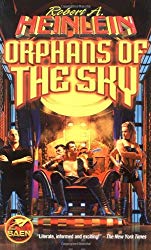
Born and raised aboard a lost starship, Hugh and his companions know nothing beyond the metal walls of their home, until Hugh is captured by the muties, grotesquely deformed human parodies who lurk in the upper reaches of the ship and who reveal the true nature of the ship and its mission.

Narrated by a generation ship’s AI, Aurora tells the story of Freya, the captain’s daughter, as the humans on the ship deal with technical and biological problems on the ship. Things get much more complicated when they actually reach their destination.
“This ambitious hard SF epic shows Robinson at the top of his game… [A] poignant story, which admirably stretches the limits of human imagination.” ―Publishers Weekly

Nightside the Long Sun takes place after the events in author Wolfe’s extremely well-regarded Book of the New Sun , and is the first book in a four-volume series.
Inside the giant spaceship known as the Whorl , the gods speak to their worshipers through a complex system of augury and technology until one man discovers the existence of a new god and unwittingly begins a revolution.
“The atmosphere of Wolfe’s spacecraft seduces and amazes, details and mystery piling upon each other to yield a sense of palpable otherworldliness.” —Publishers Weekly
“Wolfe’s stylistic genius allows him to infuse standard elements of mystery and adventure with multiple layers of nuance and symbolism to create a transcendent and mysterious whole.” —Library Journal

An uncontested sci-fi classic, Rendezvous with Rama is also one of Clarke’s best novels, winning the Campbell, Hugo, Jupiter, and Nebula Awards.
A huge, mysterious, cylindrical object appears in space, swooping in toward the sun. The citizens of the solar system send a ship to investigate before the enigmatic craft, called Rama , disappears. The astronauts given the task of exploring the hollow cylindrical ship are able to decipher some, but definitely not all, of the extraterrestrial vehicle’s puzzles. From the ubiquitous trilateral symmetry of its structures to its cylindrical sea and machine-island, Rama ’s secrets are strange evidence of an advanced civilization. But who, and where, are the Ramans, and what do they want with humans? Perhaps the answer lies with the busily working biots, or the sealed-off buildings, or the inaccessible “southern” half of the enormous cylinder. Rama ’s unsolved mysteries are tantalizing indeed. Rendezvous with Rama is a fast-moving, fascinating must-read for science fiction fans.

Originally published in four volumes nearly fifty years ago, Cities in Flight brings together the famed “Okie novels.” Named after the migrant workers of America’s Dust Bowl, these novels are a bleak look at a world where cities roam the galaxy looking for work and a sustainable way of life. In the first novel, They Shall Have Stars , humanity has thoroughly explored the Solar System, yet the dream of going even further seems to have died in all but one man. His battle to realize his dream results in two momentous discoveries. In A Life for the Stars , it is centuries later and this is where the generation ships appear. To describe the other two books would reveal too much.
“A compelling future history, a tale of thistledown cities blown by the winds of time… [A]n exciting tale deepened and made utterly plausible by Blish’s craft and his mature understanding of people and history. If you haven’t read this yet, I envy you. Blish s cities will fly through your dreams.” —Stephen Baxter
(Thanks to reader Michael B. for bringing this book to my attention.)
24 thoughts on “ 19 Best Generation Ship Books ”
Another interesting list – thanks for your work. I already had the Greg Bear and KSR waiting to be read.
It might’ve had a fancy respray, but the cover art for #16 clearly shows a Twin-Pod Cloud Car (from The Empire Strikes Back)! The details are instantly familiar to me as I had a toy one and my long-suffering parents had to buy me not one but two Twin-Pod Cloud Car Pilot figures. 🙂
Trying to remember which books were about a girl kidnapped by Wisps and taken to a spaceship that battle different alien species to sell that species as soldiers to other aliens.The girl was put on a maintenance crew on the ship.
Love your top three picks. Kim Stanley Robinson’s Aurora is a masterpiece, a wonderful ecological parable/statement, and fun in the way it critiques the generation ship genre. A very lean and thrilling book too (from an author who generally tilts toward a deliberately slow/banal style).
Nightside the Long Sun, in contrast, is completely different. This is a sprawling, ambitious epic, very playful, and tilts often into the fantasy/sword-and-sorcery genre.
And of course Rendevous With Rama is an outright classic. Dated in some respects, it’s nevertheless a fun, weird adventure, and often engenders feelings of being in the presence of something truly big and alien.
As a fan of the genre, who tries to consume every generation ship novel out there, I’d have these three in my top three as well, though I’d probably reverse the order and put Clarke’s book third.
Here’s an offbeat generation ship recommendation for you: The Dazzle of Day.
I remember a TV show, probably in the BBC’s ‘Out of the Unknown’ series, perhaps based on a short story, of a multi-generation space mission where the travellers no longer knew they were on a spaceship, and worshipped a tree, I think. Anyone know what this was? Thanks.
The StarLost, a Canadian TV series from the early 1970s.
“Ship of Fools” – Richard Paul Russo?
I think the Generations trilogy by Scott Sigler belong there. Alive, Alone and Alight are good books.
You should really check out John Thornton’s vast writings about colony ships. His 30 plus books are amazing! Colony Ship Eschaton, Colony Ship Vanguard, Colony Ship Conestoga, Colony Ship Trailblazer, and Colony Ship Warren.
Stephen Baxter’s Ring should be on this list.
The two novellas that comprise “Orphans of the Sky” were originally published in 1941. So, while the combined volume was published in 1963, the works were written in 1941 or earlier.
Knowing the actual date of publication changes the nature of the work from derivative to ground breaking.
Uh… Cirocco Jones, the captain in John Varley’s novel Titan , is a woman. https://en.wikipedia.org/wiki/Titan_(Varley_novel)
Trying to remember a generation ship book written before the early 60’s. My most vivid memory is of the main character exploring his world and seeing marks on walls that he didn’t understand was writing but us readers could see it was DECK 53 etc. Unknown to him, the ship was circling the Earth (I think) and being maintained by people from Earth because the people on the ship were regarded as a sort of primitive race who would not be able to coexist on Earth! I’d love to read that story again! Does anyone know the book? Thanks.
I believe you’re looking for “Starship” by Brian Aldiss circa 1958.
Thanks for your reply but I’m actually reading Starship at the moment. It’s similar to what I remember but the main characters are much more advanced than the primitive ones in the story I’m looking for, I think! When I get to the end of Starship maybe I’ll change my mind/memory:)
‘Starship’ was originally published in the UK as ‘Non-Stop.’ [Ed: spoiler deleted]
‘Non-Stop’ By Brian Aldiss
This is the one you are thinking of, Mike.
A couple of noted exceptions, Footfall, Larry Niven and Jerry Puornelle, and also by Niven and Pournelle is Legacy of Hebron and its follow up novels. Both explore the dichotomy between earth born and space born. Just suggestions.
Oops, spell check strikes, the other book is Legacy of Heorot!
Noumenon Series by Marina J. Lostetter should be on that list, and my personal favorite, The Freeze Frame Revolution by Peter Watts.
Hello everyone, Thanks for compiling this list of very interesting reads. I am trying to remember the title of a short story or novella I read quite a long time ago. It detailed a young male teenager’s experience on a space ship. He is awoken every year or so to interact with infants conceived on the ship. The children grow from toddlers to advanced old age in what is 6 weeks or so of his existence but some 60 or 70 years of the former children. All of these children are sterile so they can not reproduce. The children experience despair and possibly madness as they age. They try to escape the ship or at least find out what else exists in the ship but to no avail. In the end, they have all died and it turns the Master AI is training the teenagers in how to be a leader. If anyone has information on this item, it would be much appreciated. Many thanks, Best regards,
You missed many, but thanks for your efforts.
What was the short story/ novella where the first starship to a nearby (?) star system to Earth, taking years, is met at the destination by a colony set up from later generation ships which had overtaken the original long ago? (read decades ago and lousy memory!)
I think that we should add The stars Are Ours by Ander Norton to this list. The first part of the book is about preparations for take-off and the second half takes place after the landing. Still, the concept of the generation ship is part of the story. Written in the early 50’s and followed by Star Born, theses YA books are early classics.
Two wonderfully written character driven generational ship novels: Record of a Spaceborn Few by Becky Chambers—How societal structure could work to sustain 100 generations until it finally got somewhere. A cozier read. The World Gives Way by Marissa Levien— Not so cozy. An imbalanced society and a phenomenal ship with more than one big flaw.
Leave a Reply Cancel reply
Your email address will not be published. Required fields are marked *
This site uses Akismet to reduce spam. Learn how your comment data is processed .
- Cast & crew
- User reviews
- TV Mini Series

A young woman's murder causes the subjects of a century-long mission to populate a new world to question the true nature of the project as they approach the point of no return. A young woman's murder causes the subjects of a century-long mission to populate a new world to question the true nature of the project as they approach the point of no return. A young woman's murder causes the subjects of a century-long mission to populate a new world to question the true nature of the project as they approach the point of no return.
- Adrian Cruz
- Philip Levens
- Tricia Helfer
- Gil Bellows
- Brian Van Holt
- 201 User reviews
- 12 Critic reviews
- 3 nominations

- Viondra Denniger

- Harris Enzmann

- Captain William Denninger

- Dr. Juliet Bryce

- Aaron Gault

- Emily Vanderhaus

- James Toback

- John Stokes

- Duke Vanderhaus

- Katherine Warren

- Samantha Krueger

- Councilman Rose

- Christa Valis

- Robert Bryce

- Lorelei Wright

- Eva Marceau
- All cast & crew
- Production, box office & more at IMDbPro
More like this

Did you know
- Trivia Christa's last name is Valis. Valis is the name of one of Philip K. Dick's last novels, the first of an unfinished trilogy, and stands for Vast Active Living Intelligence System, Dick's gnostic vision of one aspect of God.
- Goofs Throughout the series we see the occupants of Ascension apparently experiencing normal Earth gravity. In deep space there are only two ways to simulate the effects of gravity; either you build a ship that rotates around a central axis, where centrifugal force gives the appearance of gravity at the rim, or you rely upon thrust from the engines. Since Ascension is clearly not cylindrical (all through the series we see flat floors and a deck layout along the axis), the apparent force of gravity must therefore be provided by thrust from the engines. To approximate the gravity of Earth, the engines would need to provide a constant acceleration of 9.81m/s2. At this acceleration, the ship would reach 97% of the speed of light in just 2 years and the journey to Proxima Centauri (Ascension's quoted destination) would take roughly 5.2 years. In the show, the ship has apparently been en route for over 50 years, almost 10 times as long as the journey should take. Such a speed would not be possible for a ship of this type in any case, as it would need a huge shield against interstellar material and an impossibly large fuel load. All of this is simple math and physics and could be questioned by any reasonably well-educated person in the 1960s; it's inconceivable that none of the crew or other people on board would not have questioned this inconsistency.
- Alternate versions Syfy Channel originally aired the show as three 2-hour episodes (with commercials). But Netflix has divided the series into six 43-minute episodes.
- Connections Featured in WatchMojo: Top 10 Sci-Fi Shows That Deserve a Second Chance (2017)
User reviews 201
- jerryday05-1
- Dec 18, 2014
- How many seasons does Ascension have? Powered by Alexa
- Why did Ascension air as a miniseries without a final act?
- Will there be a Season 2 for Ascension?
- December 15, 2014 (United States)
- United States
- Official Facebook
- Vesmírná loď Ascension
- Minneapolis, Minnesota, USA (skyline shots)
- Blumhouse Productions
- Sea to Sky Entertainment
- See more company credits at IMDbPro

Technical specs
- Runtime 1 hour 17 minutes
Related news
Contribute to this page.

- See more gaps
- Learn more about contributing
More to explore

Recently viewed
Help | Advanced Search
Astrophysics > Instrumentation and Methods for Astrophysics
Title: computing the minimal crew for a multi-generational space travel towards proxima centauri b.
Abstract: The survival of a genetically healthy multi-generational crew is of a prime concern when dealing with space travel. It has been shown that determining a realistic population size is tricky as many parameters (such as infertility, inbreeding, sudden deaths, accidents or random events) come into play. To evaluate the impact of those parameters, Monte Carlo simulations are among the best methods since they allow testing of all possible scenarios and determine, by numerous iterations, which are the most likely. This is why we use the Monte Carlo code HERITAGE to estimate the minimal crew for a multi-generational space travel towards Proxima Centauri b. By allowing the crew to evolve under a list of adaptive social engineering principles (namely yearly evaluations of the vessel population, offspring restrictions and breeding constraints), we show in this paper that it is possible to create and maintain a healthy population virtually indefinitely. A initial amount of 25 breeding pairs of settlers drives the mission towards extinction in 50 +/- 15% of cases if we completely forbid inbreeding. Under the set of parameters described in this publication, we find that a minimum crew of 98 people is necessary ensure a 100% success rate for a 6300-year space travel towards the closest telluric exoplanet known so far.
Submission history
Access paper:.
- Other Formats
References & Citations
- Google Scholar
- Semantic Scholar
2 blog links
Bibtex formatted citation.
Bibliographic and Citation Tools
Code, data and media associated with this article, recommenders and search tools.
- Institution
arXivLabs: experimental projects with community collaborators
arXivLabs is a framework that allows collaborators to develop and share new arXiv features directly on our website.
Both individuals and organizations that work with arXivLabs have embraced and accepted our values of openness, community, excellence, and user data privacy. arXiv is committed to these values and only works with partners that adhere to them.
Have an idea for a project that will add value for arXiv's community? Learn more about arXivLabs .
- Bahasa Indonesia
- Slovenščina
- Science & Tech
- Russian Kitchen
10 facts about Gorky Park, Moscow’s most famous park

1. Occupies almost 220 hectares on the bank of Moskva River
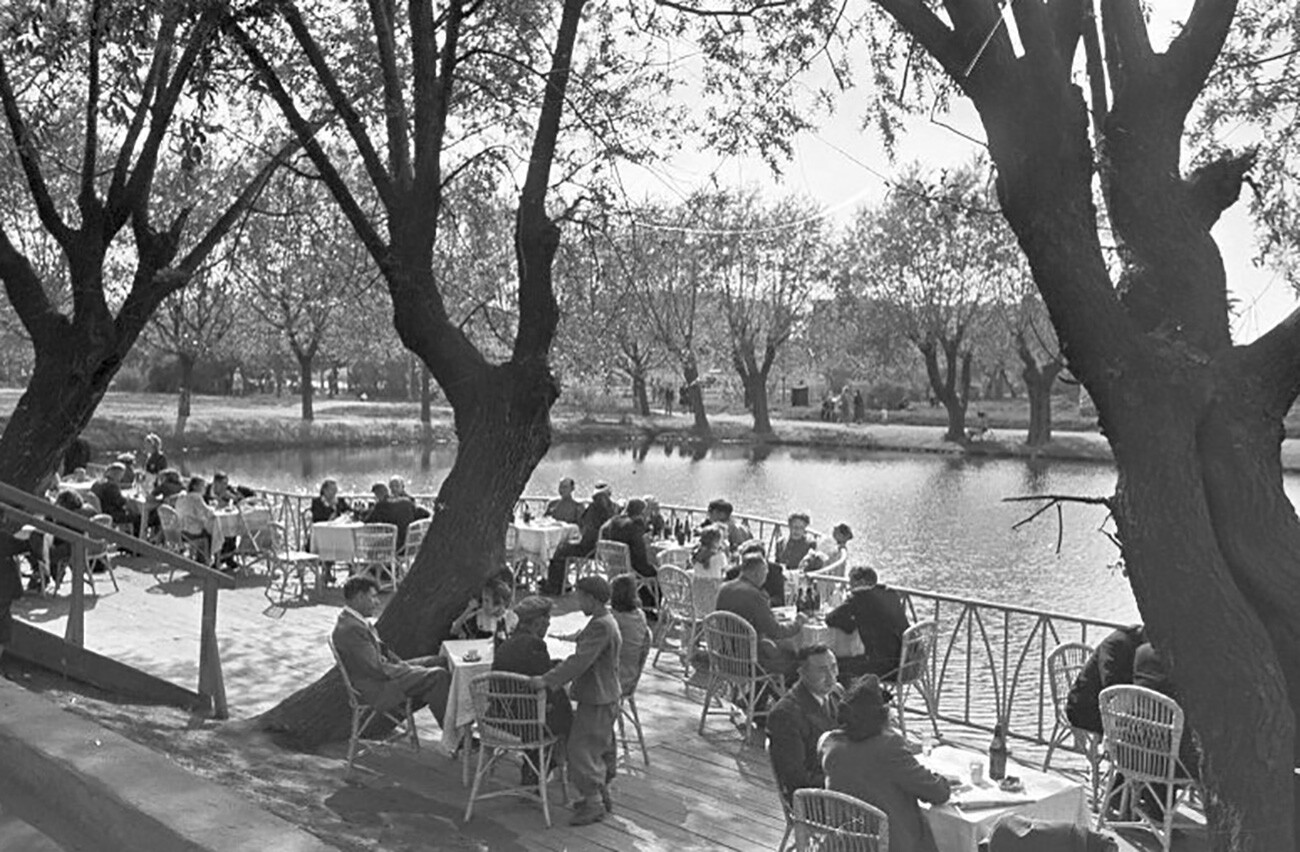
Gorky Park. Summer cafe. Late 1930s
Gorky Central Park of Culture and Leisure – that’s what this public space is officially called, with people simply calling it ‘Gorky Park’.
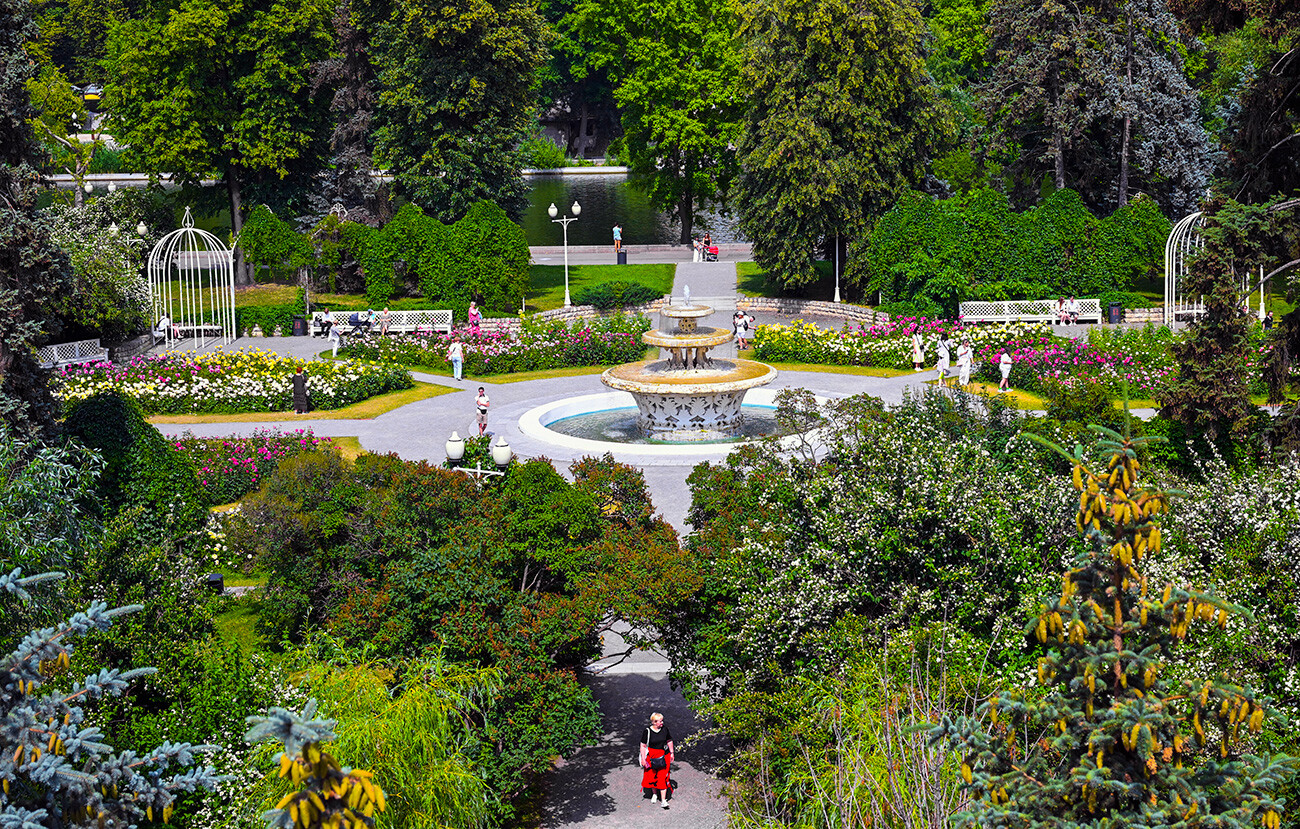
People strolling around Gorky Park
It’s located to the southwest of the center, stretching along the bend of the Moskva River.
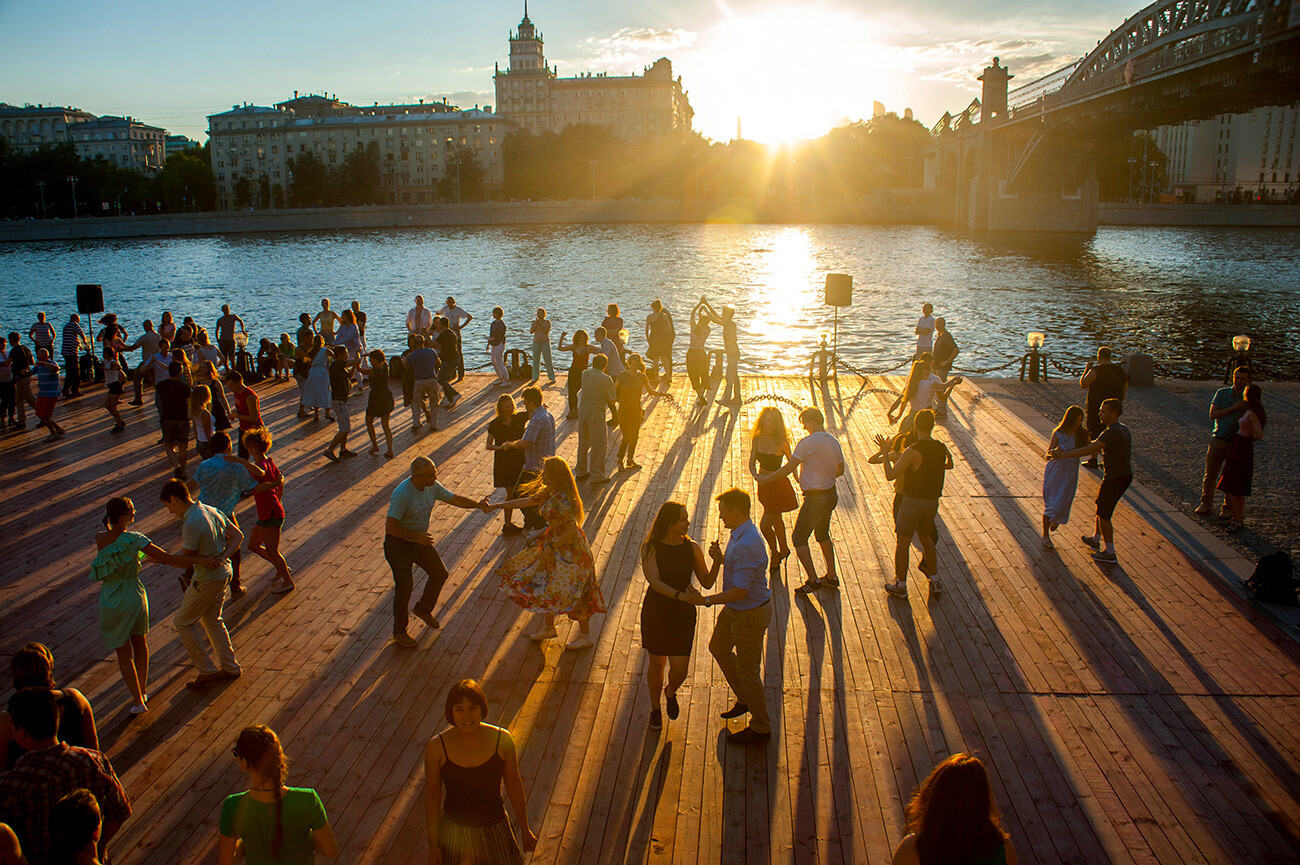
People dancing at the Gorky Park's embankment
The modern Gorky Park sprawls across almost 220 hectares of land, including large green spaces - Neskuchny Sad (‘Not Boring Garden’) and Vorobyovy Gory ( ‘ Sparrow Hills ’ ), as well as the Muzeon park of arts.
2. Began its history before the revolution

Alexandrinskaya (now Pushkinskaya) embankment and Krymsky (Crimea) Bridge, 1912-14
The history of Gorky Park began from Neskuchny Sad. In the 18th century, the country estates of noble Russian families were located there, along the right bank of the Moskva River – the Golitsyns, the Orlovs and the Trubetskoys. The estate of the latter was called ‘Neskuchnoye’.

Golitsyn rotonda of the 19th century, 1910s
It hosted grand gardens, where the capital’s nobility loved to take walks; different entertainment venues were made for them there. One after another, these estates were bought out by Nicholas I; in the 1820s-1830s, he created Neskuchny Sad and built a summer theater.
3. A ‘shop front’ for Soviet authorities
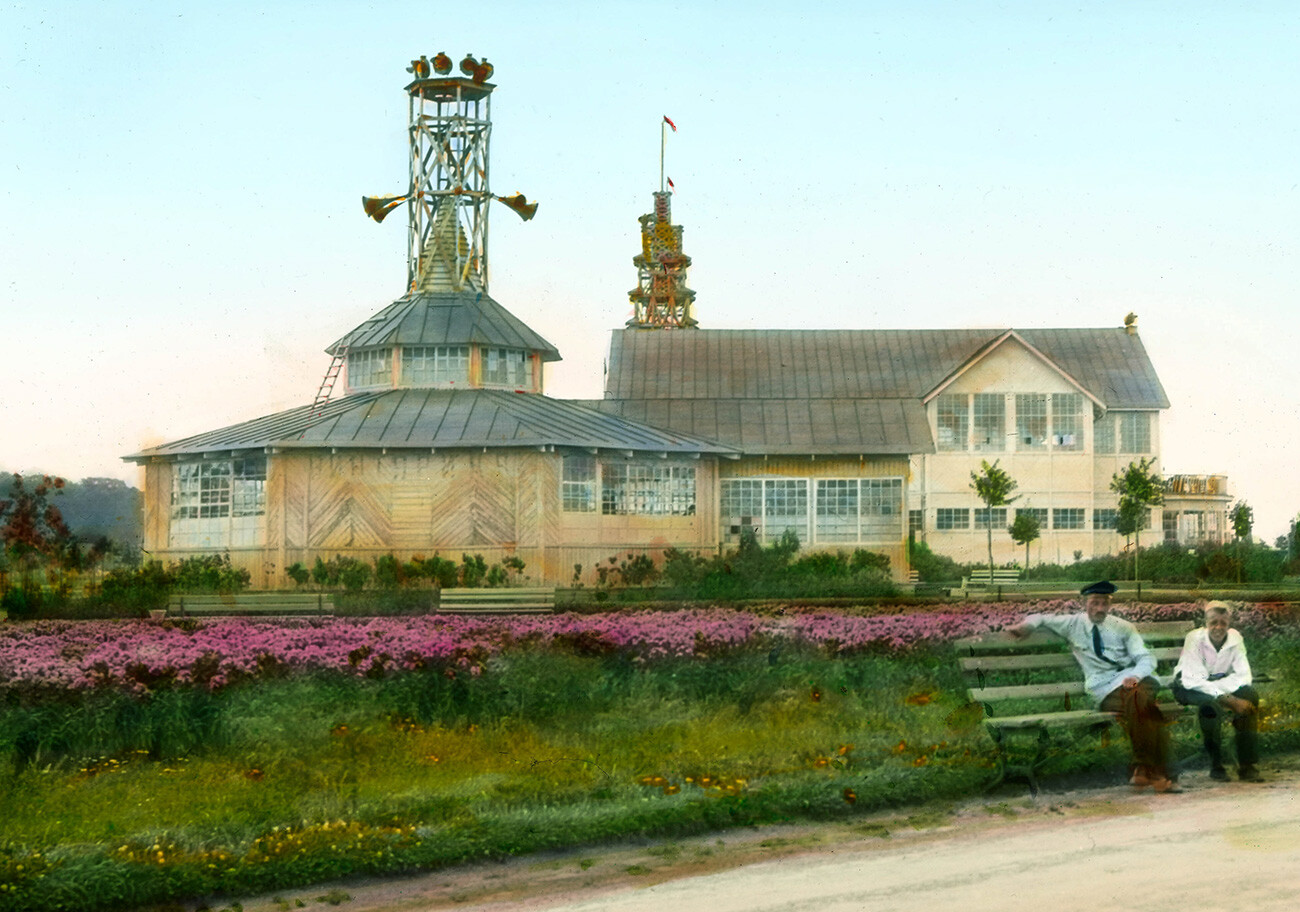
Gorky Park in 1930 through the eyes of an American photographer
After the revolution, Neskuchny Sad was nationalized and opened for visitors. In 1923, it hosted the first large agriculture and craftsmanship exhibition, long before a separate park was built for it, presently known as VDNKh.
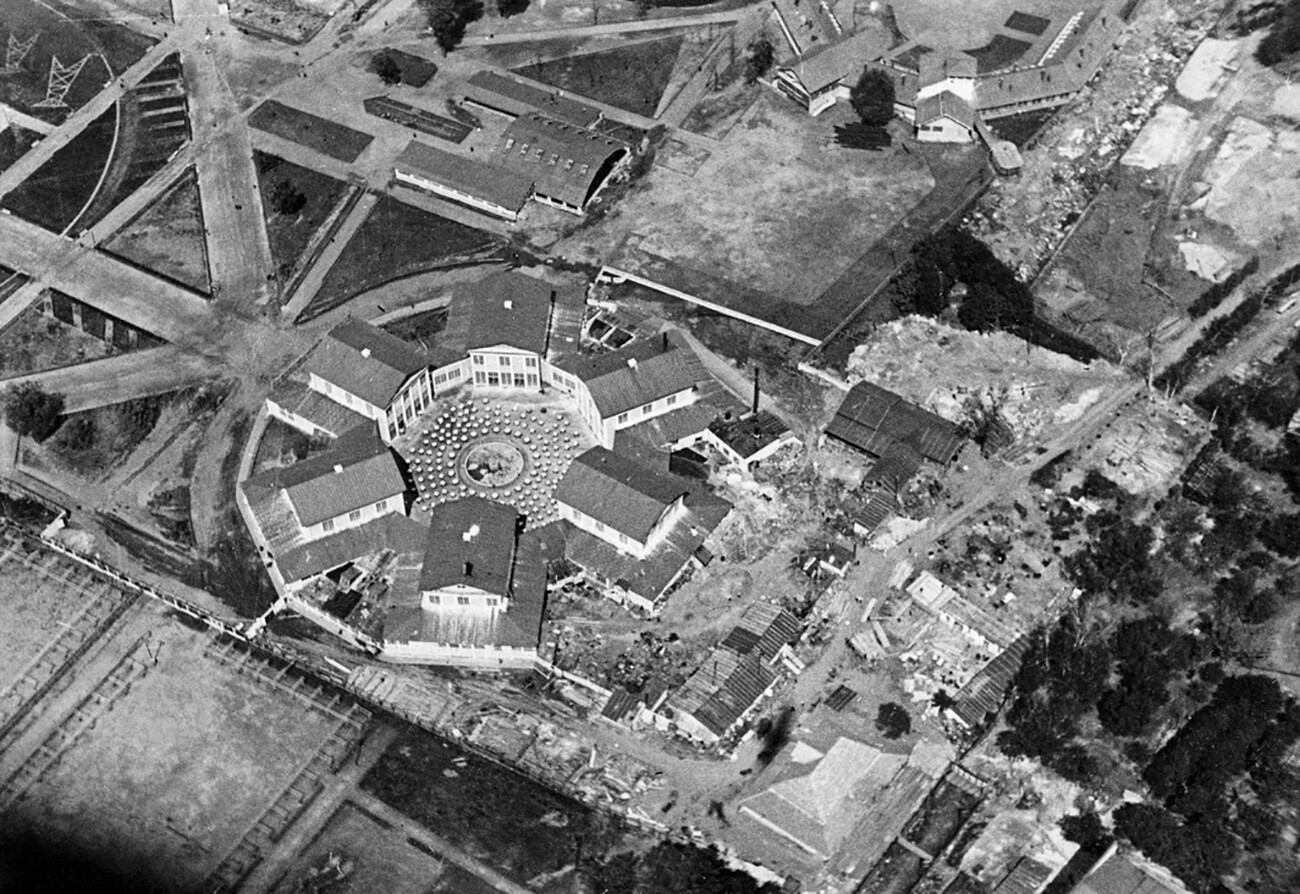
The ‘Machines and Tools’ pavilion of the agriculture and craftsmanship exhibition, 1923
The ‘Machines and Tools’ pavilion, erected for the exhibition, survives to our day – a Constructivist building in the shape of a hexagon. Currently, the Garage Museum of Contemporary Art is undergoing a reconstruction (read about this museum below).
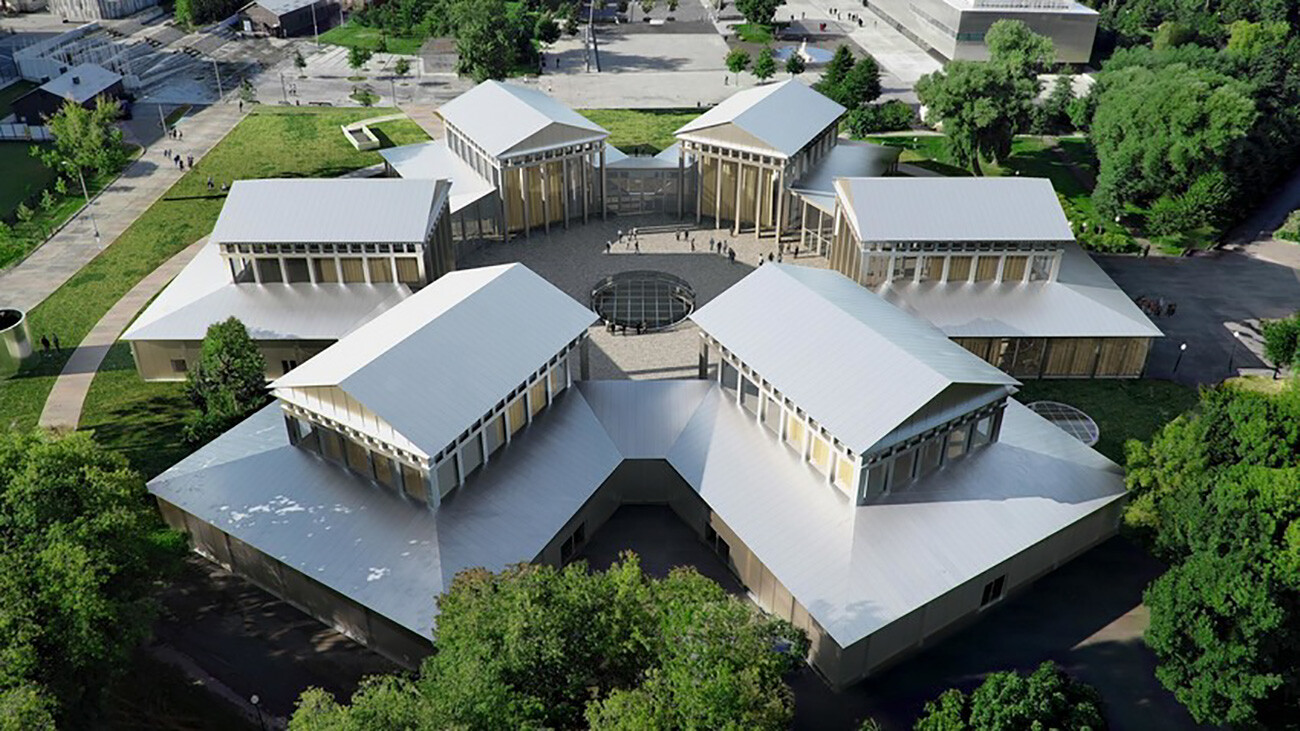
Garage Museum project for the reconstruction of the "Machines and Tools" pavilion ("Hexagon")
The planning of the future park was headed by avant-garde architect Konstantin Melnikov; other prominent innovating architects – El Lissitzky, Alexey Shchusev and Alexander Vlasov – also took part in the construction.
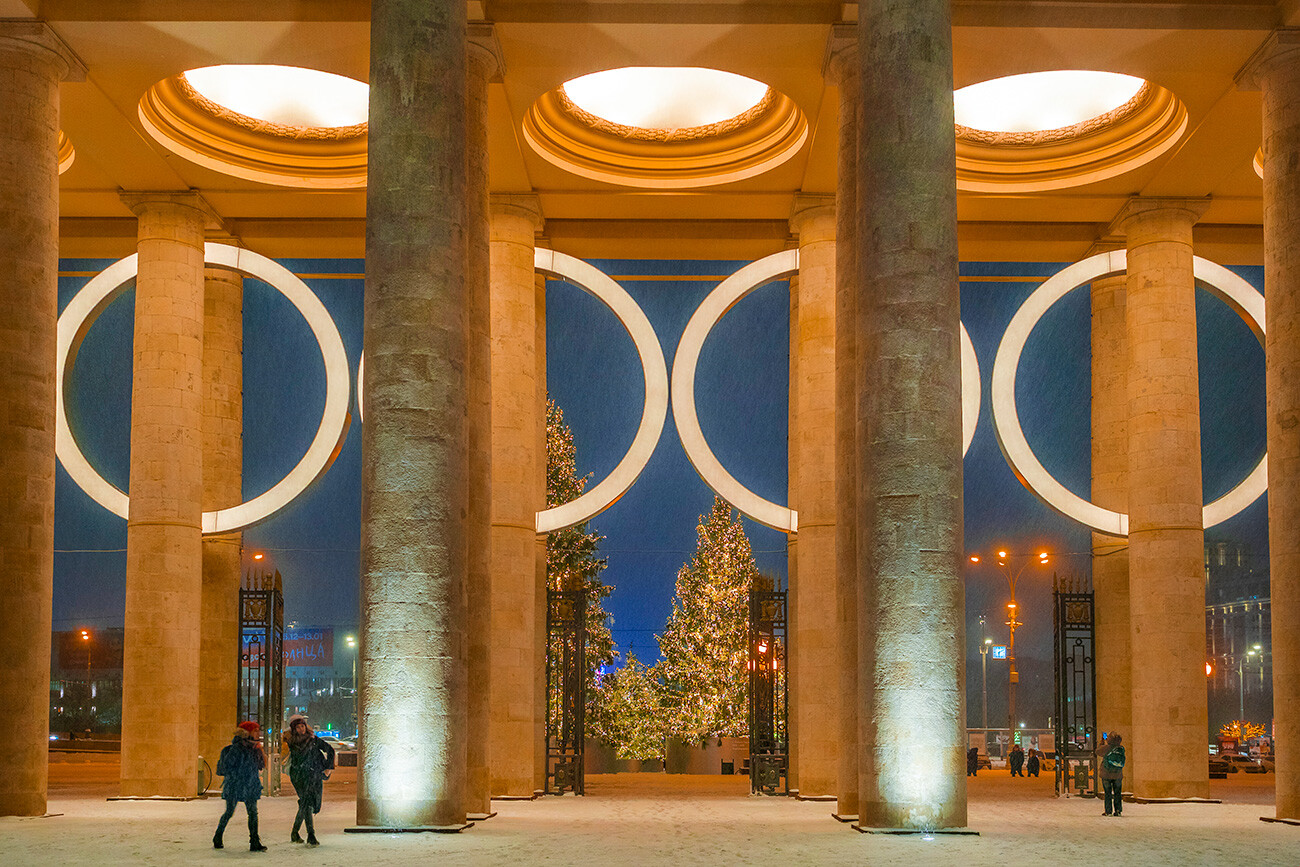
Christmas tree in front of the main entrance of Gorky Park.
And the famous main entrance arch was designed by Georgy Shchyuko in the 1950s.
4. Designed not just for leisure but also for culture

Gorky Park in 1932
On August 12, 1928, one of the first Soviet parks of culture and leisure was opened here. Cafes, dance and fitness grounds, hammocks – all the conditions for leisure were created for the working masses. Apart from that, they were supposed to spend their time there culturally.

Opening of the Central Park of Culture and Leisure in Moscow. Propaganda group "Blue Blouse" performing, 1928
Here, ‘spoken’ newspapers with the latest news were read to the proletariat; propaganda brigades delivered speeches, as well.

Autumn in Gorky Park
In 1934, the Green Theater under the open sky with a capacity of 20,000 people was opened, where musical, theater and circus performances were held.
5. Bears the name of the main Soviet author

Gorky Park's main alley, 1935
In 1932, the park was renamed after main Soviet author Maxim Gorky – and this was uncharacteristically done during his lifetime.

Golitsyn rotonda and Andreevsky Bridge
On a side note, the still-living writer also didn’t appreciate the renaming of his native city Nizhny Novgorod to Gorky. During these years, Soviet authorities created a whole cult of personality around the name of Gorky, so other cities of the USSR saw streets, parks, as well as squares renamed with his last name.
6. The first parachute tower operated here
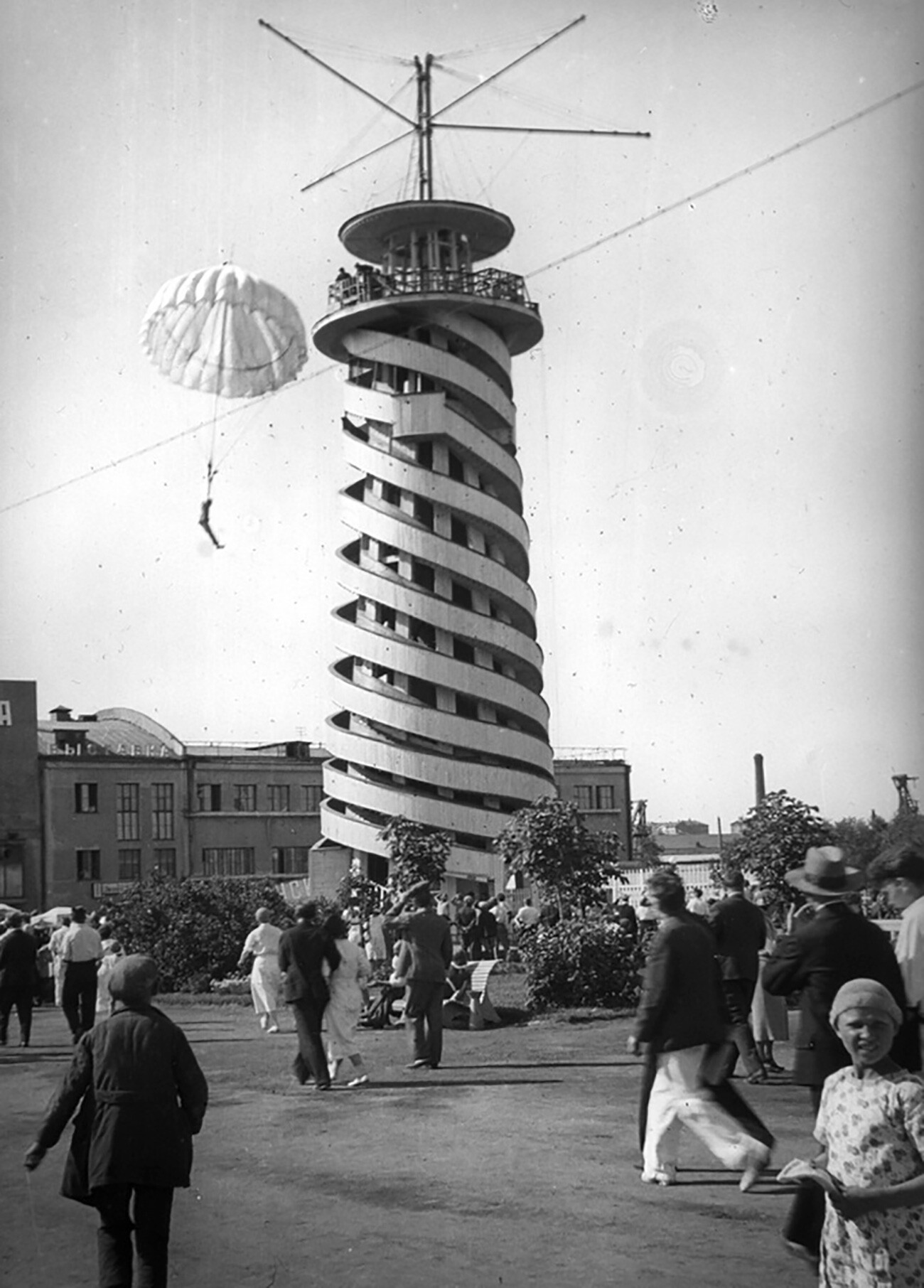
Parachute tower in Gorky Park, 1955
In the 1930s, the USSR saw a whole boom of parachuting; a unique building appeared in Gorky Park – a parachute tower. It was quite a popular attraction; anyone could descend from it with a parachute or in a spiraling chute, sitting on a special rug.
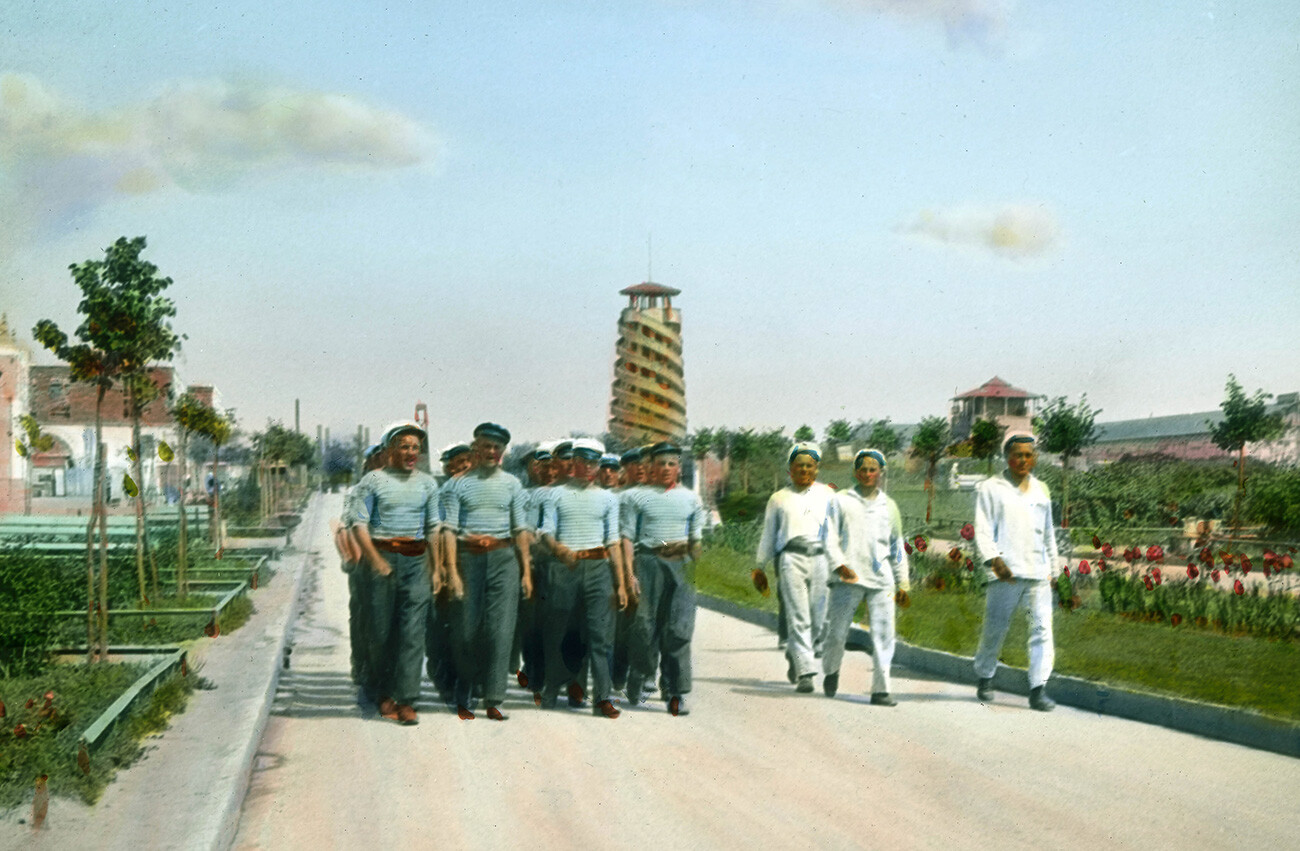
Gorky Park in 1931
In the 1950s, the tower was disassembled, because it was deemed too hazardous; ironically, before that, such attractions had been promoted across the entire USSR and in other neighboring countries.
7. In the 1990s, an amusement park was opened here
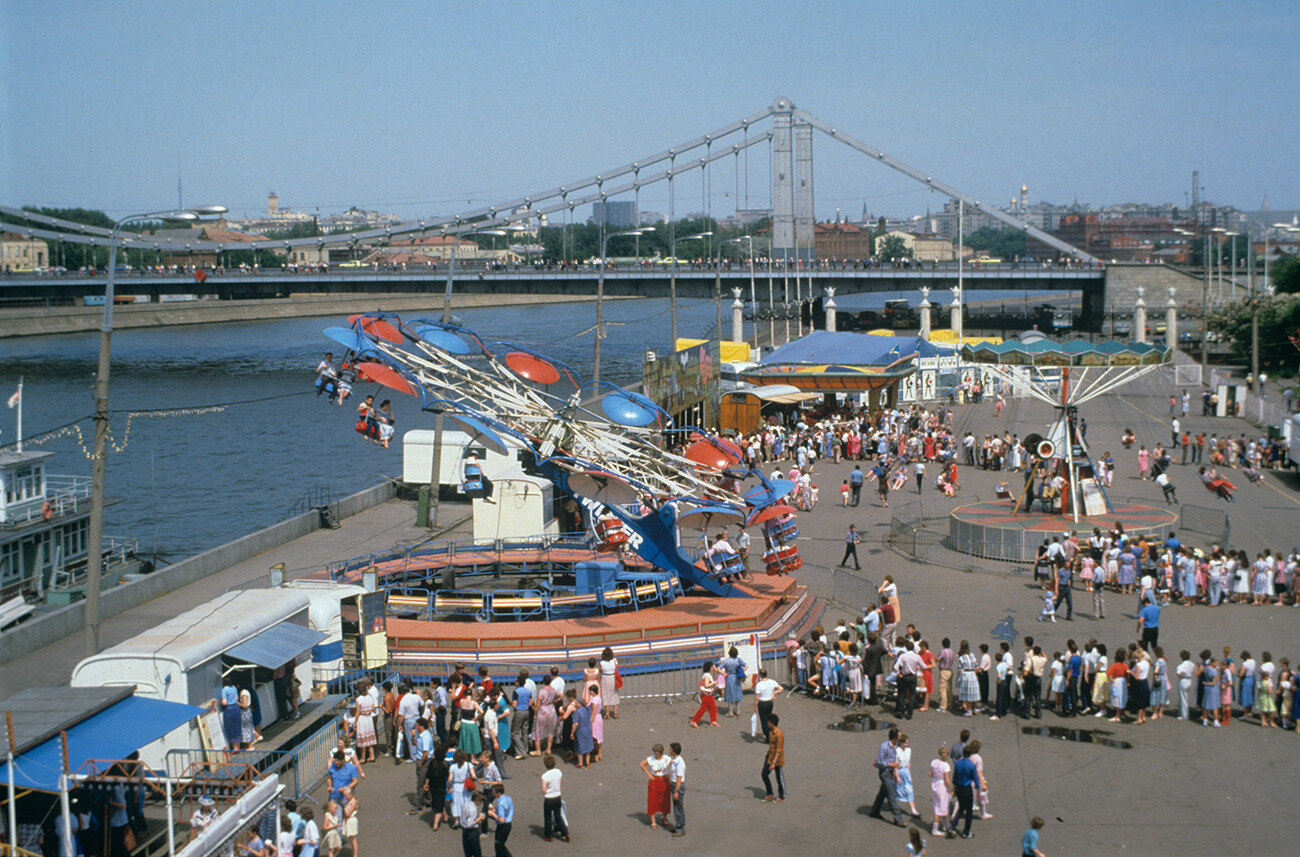
Amusement rides on Moskva River bank at Gorky Park, 1989
For the first generation of children who were born after the collapse of the Soviet Union, Gorky Park was associated with cotton candy, donuts and – most importantly – with rides.
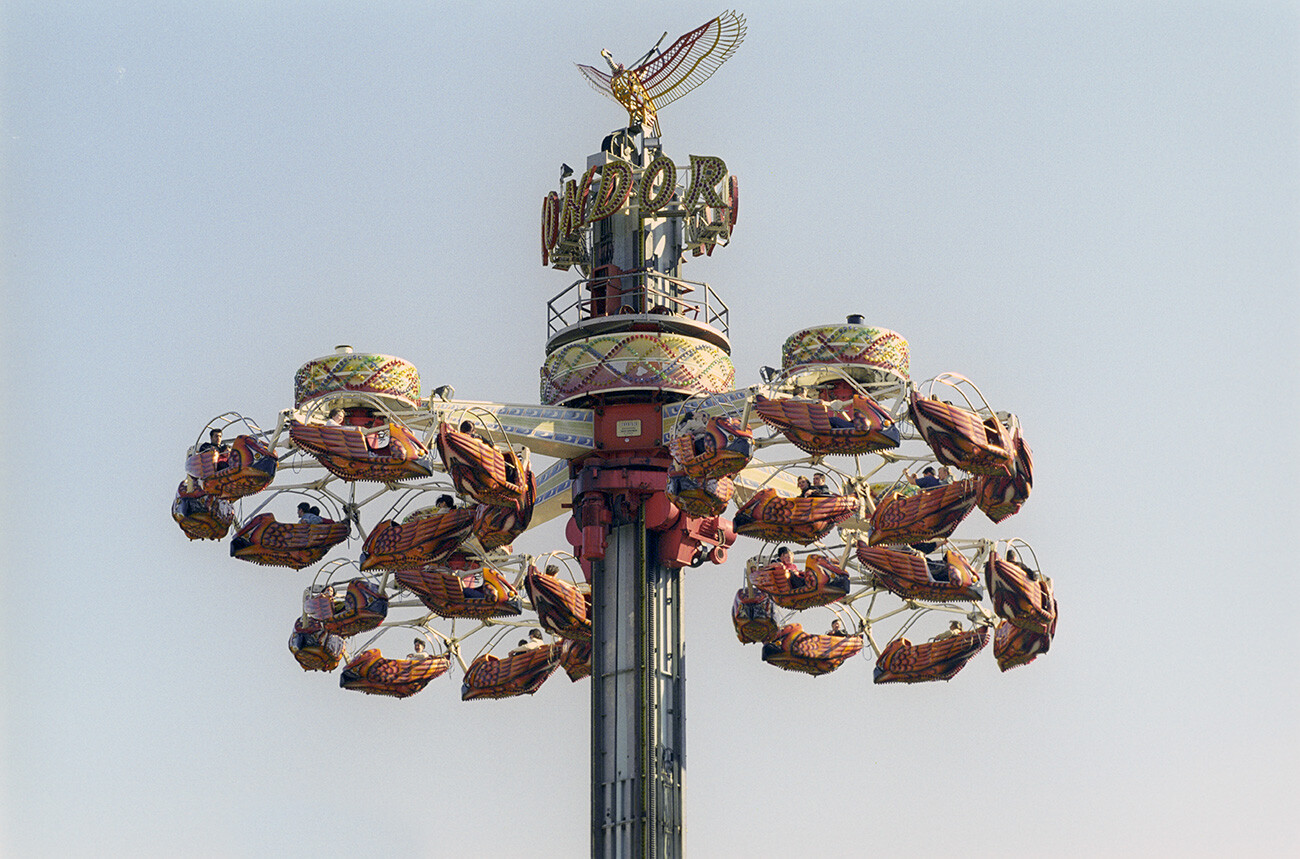
Condor amusement ride, 1998
In the Soviet era, there were just simple carousels, but, from the 1990s and until the beginning of the 2010s, dozens of rides operated in the park – basically like a sort of local “Disneyland”.
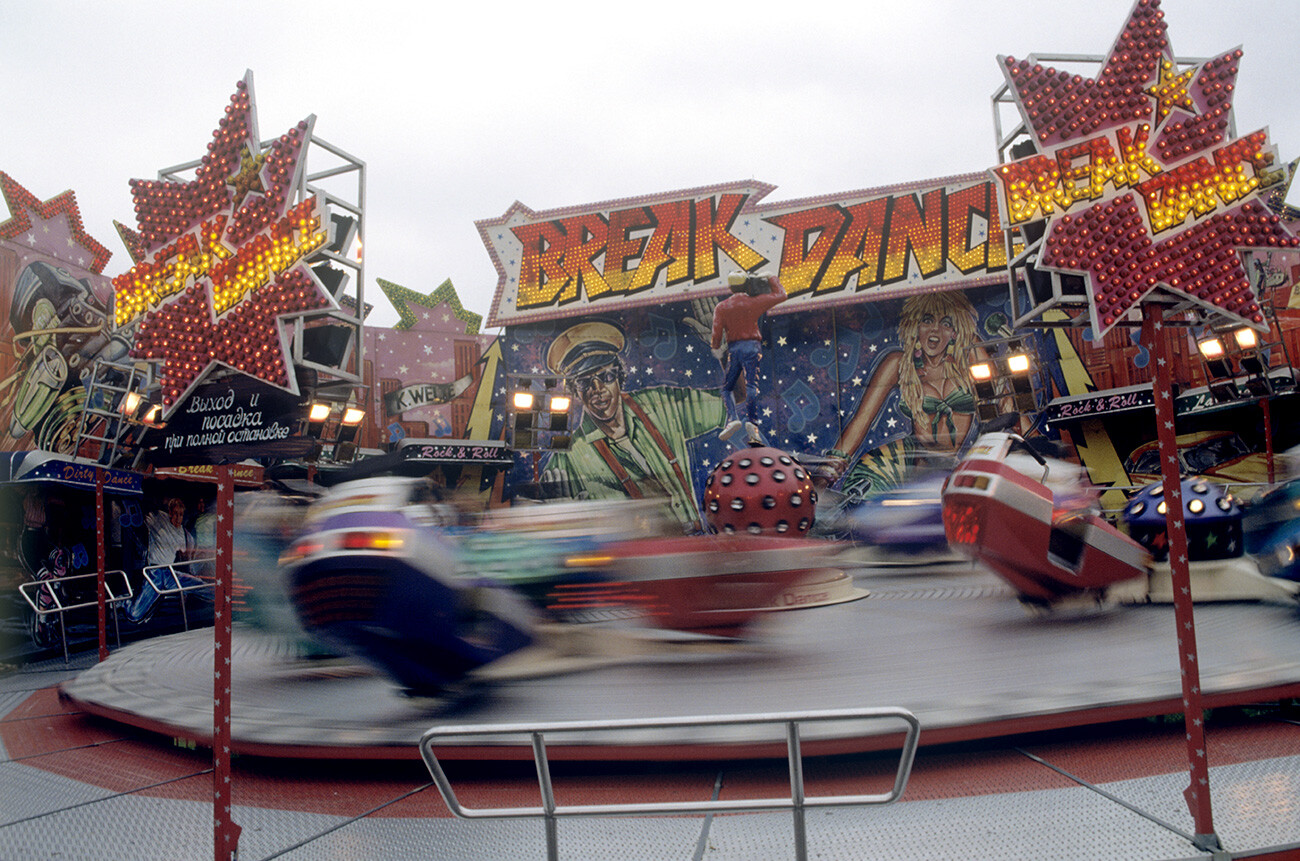
'Breakdance' ride, 1995
A rollercoaster, a haunted mansion, the ‘Niagara’ water slide, flying cars, trampolines, scary towers with spinning gondolas, a bungee over a pond and much more. There were also two Ferris wheels in Gorky Park – one smaller and one larger.
8. Renovated in the 2010s
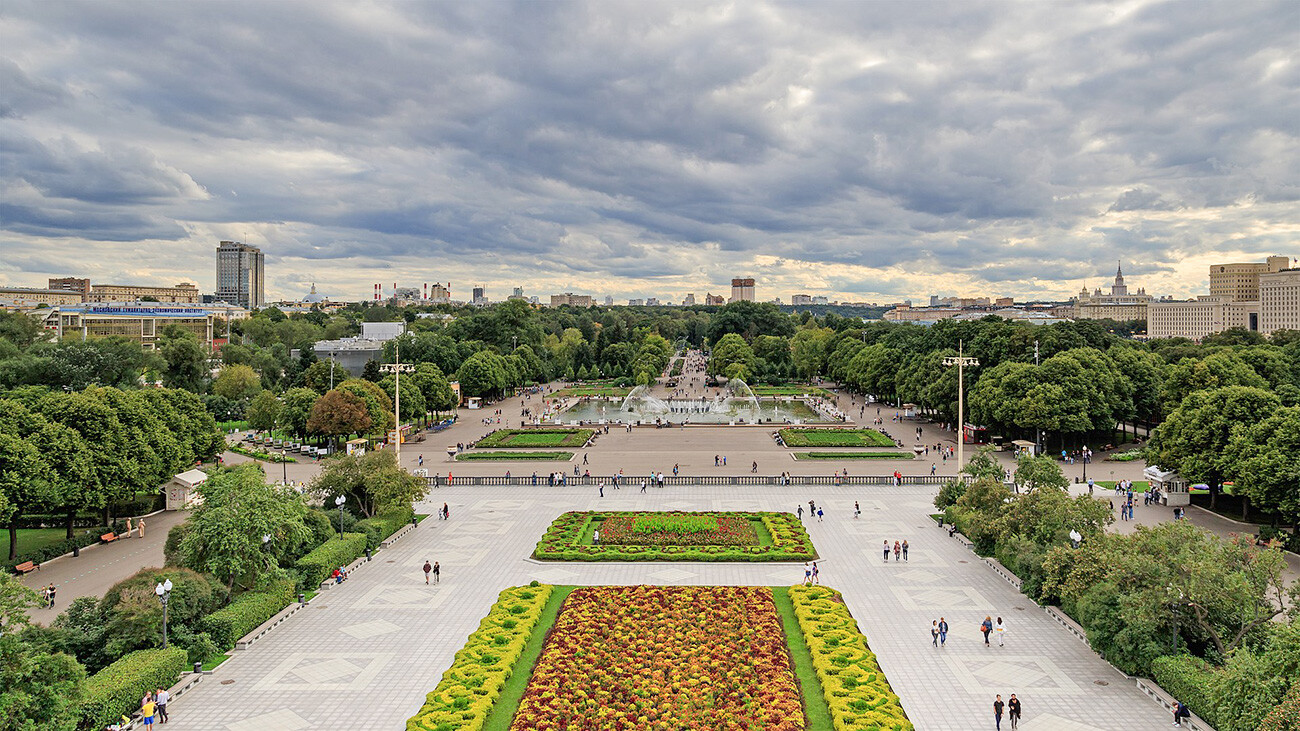
Gorky Park from above
By the beginning of the 2000s, the majority of the rides were removed, the Soviet pavilions had fallen into disarray and the park was quite a sorry sight. From May 2011, a massive renovation began, over the course of which the park became one of the most trendy and modern places in the capital.
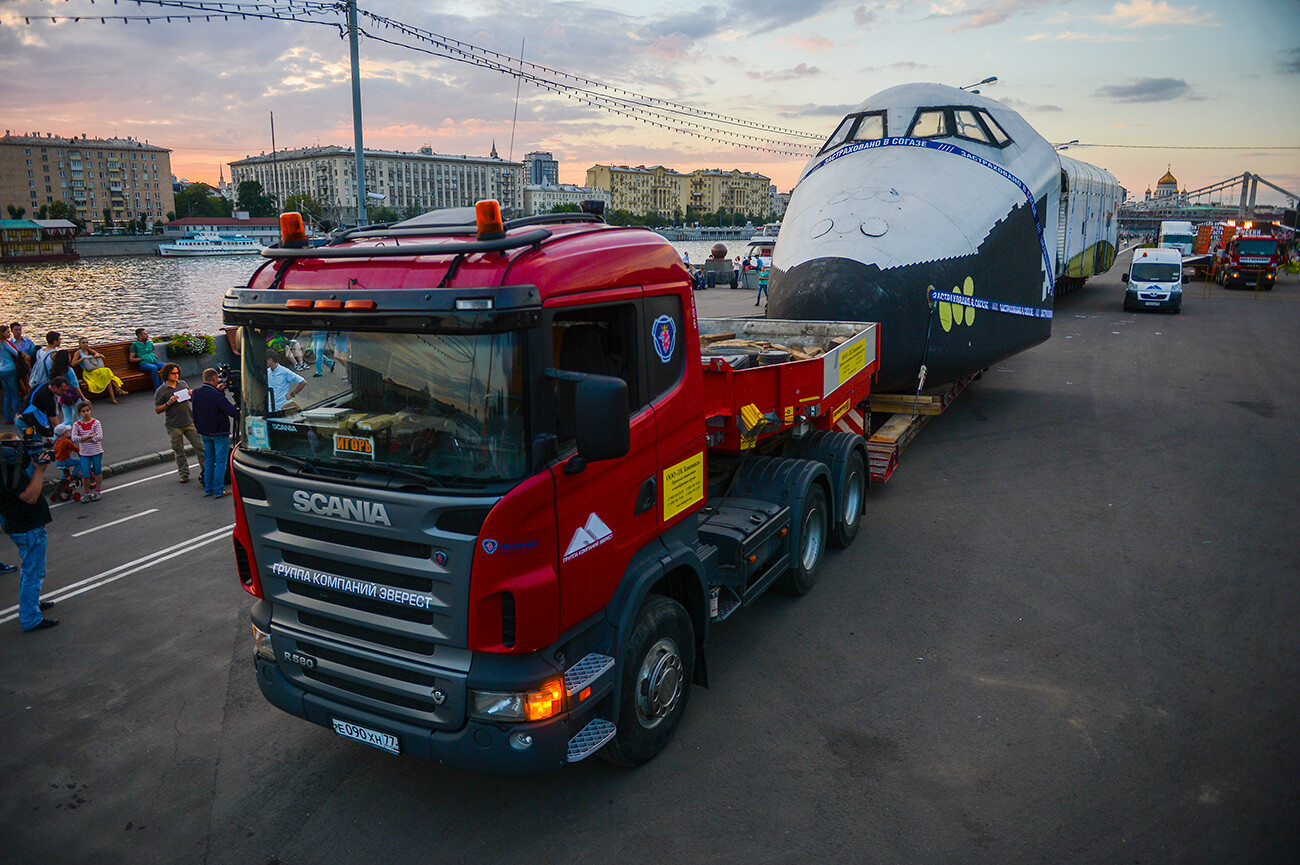
Until 2014, Gorky Park housed a model of the Buran spaceship (later it was moved to VDNKh)
Landscape design, bike lanes, sports grounds, new cafes, the first co-working spaces and one of the first free public Wi-Fi zones appeared there.
9. The main Moscow skating rink

Skating rink in Gorky Park. Late 1930s
During winter, the park’s pathways were covered with ice for ice skating back in Soviet times, as well. But, in 2011, the largest skating rink in Europe with artificial ice (at the time) was constructed in the park. For the first time, people could ice skate without having to wait for negative temperatures; hence, the ice skating season lasted until the middle of March.
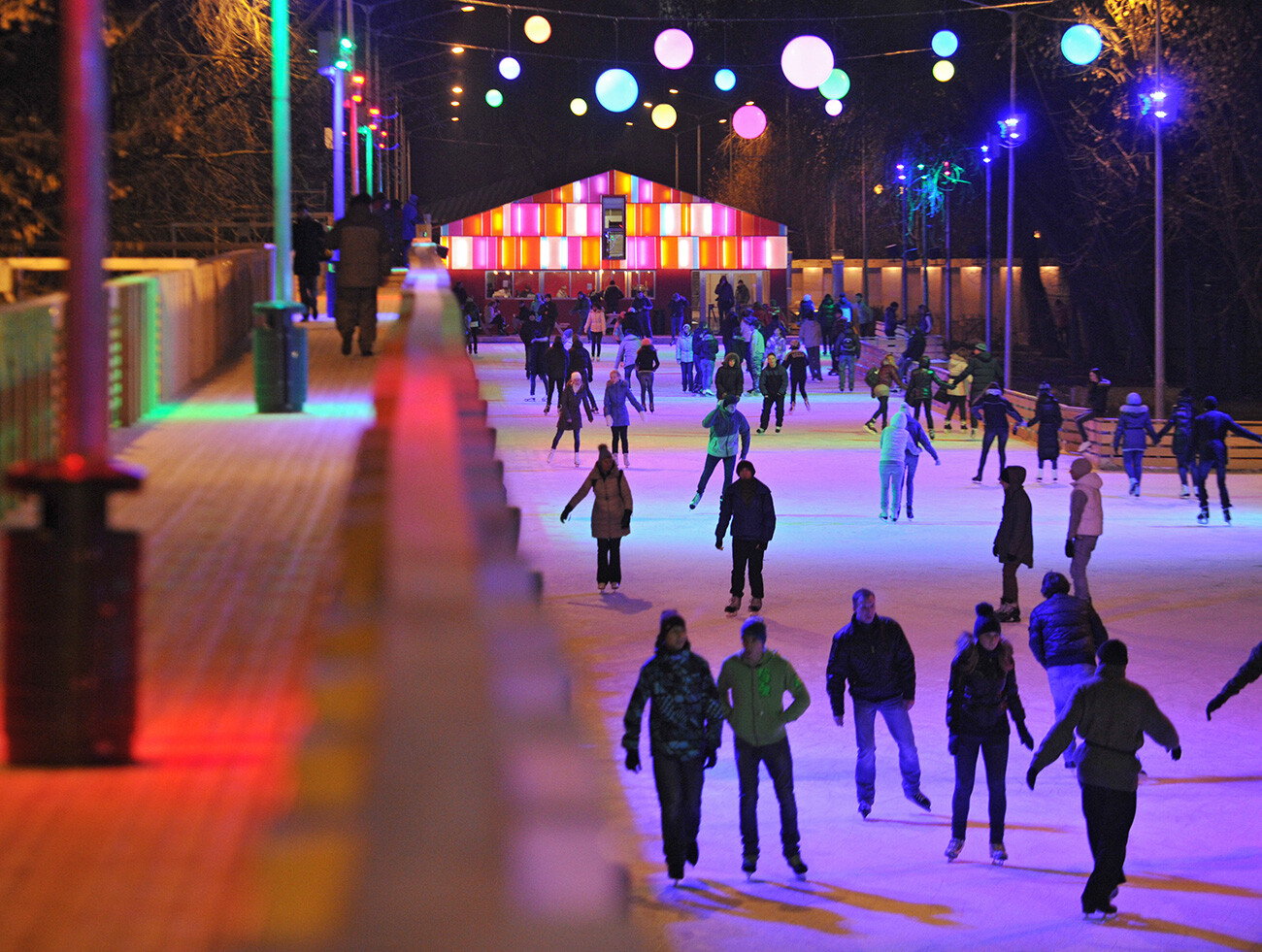
Gorky park's skating rink is now one of the largest in Europe
The total area of tracks and ice surface amounted to 15,000 square meters. Music, tents with tea and mulled wine, warm changing rooms and skate rentals supplemented the rink.
10. The Garage Museum of Contemporary Art
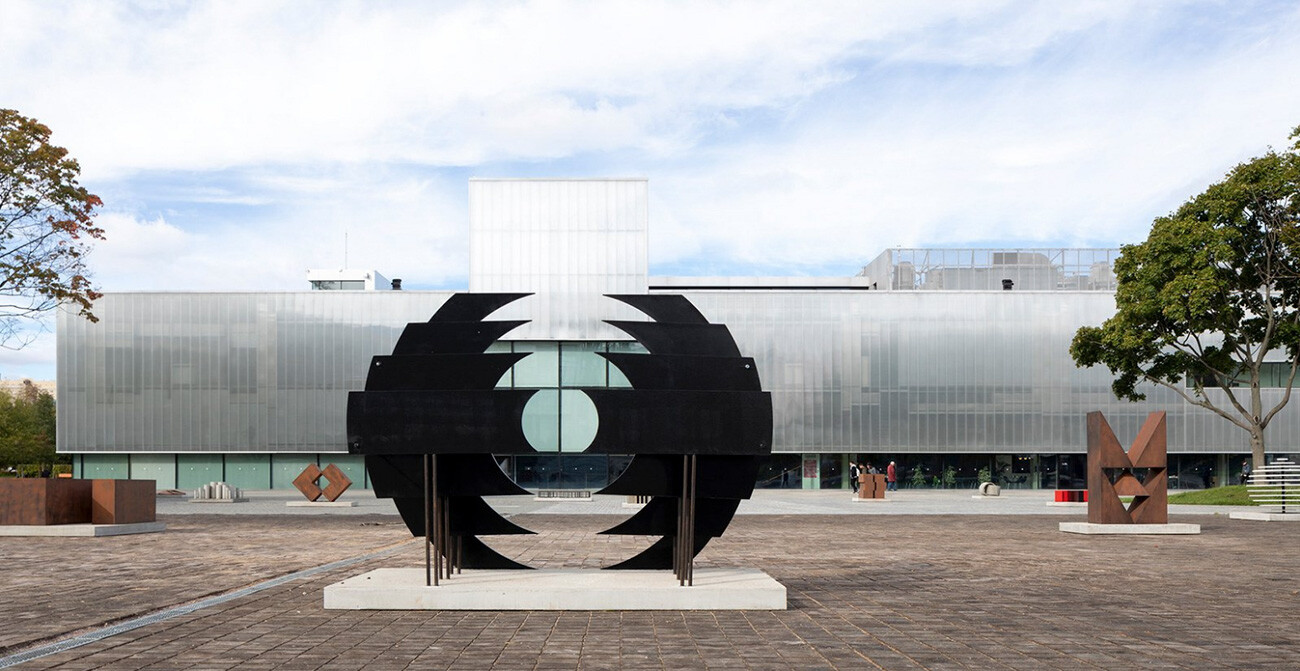
In 2012, one of the most trendy and influential cultural institutions – the Garage Museum of Contemporary Art, founded by Darya Zhukova and Roman Abramovich in 2008 – moved to Gorky Park. In many ways, it is this museum that is responsible for the “cultural leisure” Muscovites now experience in the park, conducting a broad number of exhibitions and lecture programs.
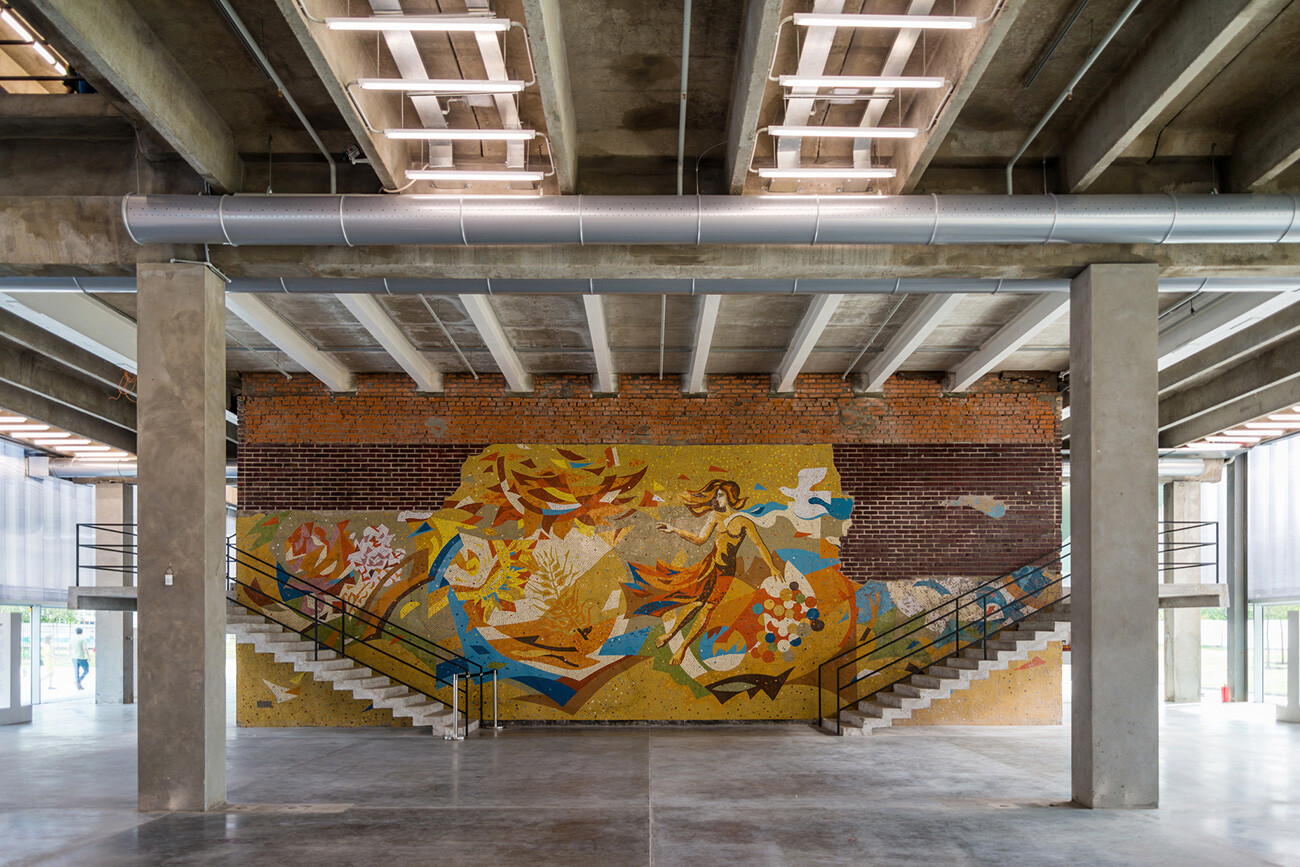
Soviet mosaics inside the Garage museum
The museum is located in the former building of the ‘Seasons’ restaurant, which was built in 1968. It was renovated for the Garage Museum by famous Dutch architect Rem Koolhaas and his OMA office. He turned the practically ruined Soviet building into a modern museum, taking into great consideration the surviving details, incorporating them successfully into the new design. And an old Soviet mosaic mural became one of the features of the new museum.
Dear readers,
Our website and social media accounts are under threat of being restricted or banned, due to the current circumstances. So, to keep up with our latest content, simply do the following:
- Subscribe to our Telegram channel
- Subscribe to our weekly email newsletter
- Enable push notifications on our website
- Install a VPN service on your computer and/or phone to have access to our website, even if it is blocked in your country
If using any of Russia Beyond's content, partly or in full, always provide an active hyperlink to the original material.
to our newsletter!
Get the week's best stories straight to your inbox
- 5 reasons why Soviet writer Maxim Gorky is so great
- 10 leading Soviets after whom cities were named
- The most BEAUTIFUL parks & gardens in Moscow (PHOTOS)
This website uses cookies. Click here to find out more.

Surviving Multi-Generational Travel: Tips for Keeping the Peace on Family Vacations
A re you planning a trip with kids and grandparents keep scrolling to check out my top tips for multi-generational travel to keep you sane.
The post Surviving Multi-Generational Travel: Tips for Keeping the Peace on Family Vacations appeared first on Marcie in Mommyland .

- Skip to primary navigation
- Skip to main content
- Skip to primary sidebar
- Skip to footer
TravelAwaits
Our mission is to serve the 50+ traveler who's ready to cross a few items off their bucket list.
19 Unique And Fabulous Experiences In Moscow

- Destinations
Thinking of visiting Russia? When visiting such a famous city, one must, of course, visit the iconic landmarks first. Moscow has plenty of those, most of them in the center of the city, which is very well-planned for tourists. Once you’ve seen the sights that are on most travelers’ lists, it’s time to branch out and visit some of the lesser-known sites, and there are some fascinating places to see and things to do.
I know this list is long, but I just couldn’t help myself. You probably won’t have the time to see them all. But that’s okay. Just scroll through the list and choose what sounds the most interesting to you. Where possible, make sure to book in advance, as things can get crowded, especially during high season.

1. The Red Square, Kremlin, And Surroundings
Red Square (Krasnya Ploshad) is the heart and soul of Russia, and where much of the country’s history has unfolded. This is the most famous landmark in Moscow and indeed the whole country, it’s an absolute must-do! The square is always full of people and has a rather festive atmosphere!
Saint Basil’s Cathedral
This is the famous church with the rainbow-colored, onion-domed roof. The cathedral was commissioned in the 1500s by Ivan the Terrible and according to legend, the Tsar thought it was so beautiful, that he ordered that the architect’s eyes be cut out afterward, so he could never build anything more beautiful! He wasn’t called Ivan the Terrible for no reason!
Lenin’s Mausoleum
The “love-it-or-hate-it” of tourist attractions in Russia. A glass sarcophagus containing the embalmed body of Russian revolutionary, Vladimir Lenin. It may seem a bit bizarre to display the mummy of a person, but it has been there for almost half a century and the 2.5 million visitors who come each year, clearly feel the queuing and thorough body search are worth it, to be in Lenin’s presence.
Pro Tip: no photos and no loud talking are allowed inside the Mausoleum.
Eternal Flame
There is an Eternal Flame in honor of an unknown soldier on the left side of Red Square. The hourly changing of the guards is worth seeing.
The Kremlin is the official residence of the Russian president. You can see it from the outside, or you can take an excursion to one of the museums located inside. This is the biggest active fortress in Europe, and holds a week’s worth of attractions! Once behind the 7,332-feet of walls, there are five squares, four cathedrals, 20 towers, various museums, and the world’s largest bell and cannon to see. Worth a special mention is the Armory Chamber that houses a collection of the famous Faberge Eggs.
Pro Tip: You can only go inside the Kremlin if you are part of a tourist group.

2. Bolshoi Theatre
Bolshoi Theatre translates to “The Big Theatre” in Russian, and the building is home to both the Bolshoi Ballet and Bolshoi Opera — among the oldest and most famous ballet and opera companies in the world.
Pro Tip: It’s hard to get an inexpensive ticket, so if you’re reading well in advance of going to Moscow then try buying tickets on the official website . Last-minute tickets cost around $250 per person. If this is out of your budget, about an hour before a performance, you can try buying a ticket at the entrance from a reseller. Most can speak enough English to negotiate the price.
Tour the Bolshoi Theatre: You can take a group guided tour of the Bolshoi Theatre which focuses on the history and architecture of the theatre and behind the scenes. There’s an English language tour that lasts 2 hours and costs around $300 for a group of up to six.

3. Luxury Shopping At GUM And TSUM
Russia’s main department store, GUM, has a stunning interior that is home to over 100 high-end boutiques, selling a variety of brands: from luxurious Dior to the more affordable Zara. Even if shopping is not on your Moscow to-do list GUM is still worth a visit; the glass-roofed arcade faces Red Square and offers a variety of classy eateries. TSUM, one of the biggest luxury malls in town, is right behind the Bolshoi and GUM. It’s an imposing building with lots of history, and worth a visit just for its design and its glass roof.

4. Christ The Savior Cathedral
This is one of Russia’s most visited cathedrals and is a newer addition to the gorgeous array of Muscovite cathedrals, but don’t let its young age fool you. After perestroika, in the early 90s, the revived Russian Orthodox Church was given permission to build a cathedral on this site. It did the location honors and built the largest temple of the Christian Orthodox Church. The façade is as grand as you’d expect, but it’s the inside that will mesmerize you, with its domes, gold, gorgeous paintings, and decor!
The cathedral is located just a few hundred feet away from the Kremlin and was the site of the infamous Pussy Riot protest against Putin back in 2012.
Pro Tip: Bring a shawl to cover your hair as is the local custom.

5. Gorky Park
Moscow’s premier green space, Gorky Park (Park Gor’kogo) is the city’s biggest and most famous park. There is entertainment on offer here for every taste, from outdoor dancing sessions to yoga classes, volleyball, ping-pong, rollerblading, and bike and boat rental in summer. In winter, half the park turns into a huge ice skating rink. Gorky Park is also home to an open-air movie theater and the Garage Museum of Contemporary Art. There is also Muzeon Art Park, a dynamic contemporary space with a unique collection of 700 sculptures. It is located right in front of Gorky Park.
6. Sparrow Hills Park
If you take a walk from Gorky Park, along the Moscow River embankment, you’ll end up in the city’s other legendary park, Sparrow Hills. Although the park doesn’t offer as many activities as its hip neighbor, it has a great panoramic view of the city
Pro Tip: You can take a free walking tour to all of the above attractions with an English-speaking guide.

7. River Cruising
One of the best ways to experience Moscow, and see all the famous landmarks, but from a different angle, is from the Moscow River. Take a river cruise. Avoid the tourist crowds. There are little nameless old boats that do the cruise, but if you are looking for a more luxurious experience take the Radisson Blu cruise and enjoy the sights with some good food and a glass of wine.

8. Metro Hopping
Inaugurated in the 1930s, the Moscow Metro system is one of the oldest and most beautiful in the world. Started in Stalinist times, each station is a work of art in its own right. I’d recommend touring the stations between 11 a.m. and 4 p.m. This way, you’ll be able to properly see it without the crowds. Ideally, I’d recommend taking a tour with a knowledgeable guide with GuruWalk, who will tell you stories of forgotten stations and how the history of the country is interconnected with the metro development. If going by yourself, then I definitely recommend checking out: Mayakovskaya, Ploschad Revolutsii, Kievskaya, Kropotkinskaya, Kurskaya, and Novoslobodskaya stations.
Visit the free Moscow Metro Museum: For real train enthusiasts, located in the southern vestibule of Sportivnaya station is a small free museum. Here you can take a peek into the driver’s cabin, see a collection of metro tokens from different cities, and see different models of a turnstile, traffic lights, escalator, and more.

9. Moscow State University View
In his effort to create a grander Moscow, Stalin had seven skyscrapers built in different parts of town; they’re called the Seven Sisters. The largest of these buildings and the one with the best view is the main building of the Moscow State University. Although this is a little outside the city center, the view is more than worth it.

10. Izmailovsky Market
Mostly known for the city’s largest flea market, the district of Izmaylovo is home to a maze of shops where you can get just about anything, from artisan crafts to traditional fur hats, handcrafted jewelry, fascinating Soviet memorabilia, and antiquities. It’s also one of Moscow’s largest green spaces. There are often no price tags, so be prepared to haggle a bit. Head to one of the market cafes for a warming mulled wine before continuing your shopping spree.
The History of Vodka Museum is found here, and the museum’s restaurant is the perfect place to sample various brands of the national drink.
Once you’ve covered the more touristy spots, Moscow still has plenty to offer, and the places below will also be full of locals! So for some local vibes, I would strongly recommend the spots below!

11. Moscow City
With a completely different vibe, Moscow City (also referred to as Moscow International Business Center) is like a mini Dubai, with lots of impressive tall glass buildings. Here is where you’ll find the best rooftops in towns, like Ruski Restaurant, the highest restaurant both in Moscow City and in Europe. Moscow City is great for crowd-free shopping and the best panoramic views of the city.

12. Tretyakov Gallery
Tretyakov Gallery started as the private collection of the Tretyakov brothers, who were 19th-century philanthropists. They gave their private collection to the government after their deaths. If there is just one museum you visit in Moscow, I recommend this one!

13. Tsaritsyno Museum-Reserve
Tsaritsyno was a residence of Catherine the Great more than two centuries ago. It became derelict during the Soviet era but has now been fully renovated. With its opulently decorated buildings, gardens, meadows, and forests, Tsaritsyno Park is the perfect place for a green respite in Moscow.

14. Kolomenskoye
A 10-minute metro ride from the city center is Kolomenskoe Museum-Reserve, where you can get an idea of what Russia looked like 200 years ago. You’ll find ancient churches (one dating back to the 16th century), the oldest garden in Moscow, and the wonderful fairytale wooden palace of Tsar Alexey Mikhailovich, father of Peter the Great.

15. Ostankino TV Tower
Built in 1967, Ostankino TV Tower was the tallest free-standing construction in the world at the time, it’s still the 8th tallest building in the world and the highest in Europe. It’s also the best observation deck, with a glass floor and 360-degree views. The speedy elevators take you 1,105 feet in next to no time.
Pro Tip: You need to book in advance; entrance is based on specific ticket times and the capacity is limited and only a certain number of tourists are allowed per day. Don’t forget your passport, you’ll need it to get through security.

16. Zaryadye Park
Zaryadye is a newly opened, landscaped urban park so new you won’t find it in a lot of tour guides. The park is near Red Square and is divided into four climatic zones: forest, steppe, tundra, and floodplains, depicting the variety of climatic zones in Russia.
These last three suggestions are a little quirky, but all are really worth checking out.
17. Museum Of Soviet Arcade Games
Release your inner child playing on 66 arcade machines from the Soviet era! What a great way to spend a couple of hours when tired of visiting museums and palaces. The staff speaks excellent English and are happy to explain how the games work.

18. Moscow Rooftop Tour
Take a 1-hour private Moscow rooftop tour with an experienced roofer. I can just about guarantee none of your friends will be able to say they’ve done it! For your comfort, I recommend wearing comfortable shoes. Take your camera, there are some amazing photo opportunities out there!

19. Sanduny Banya
This classical Russian bathhouse opened its doors in 1808 and is famous for combining traditional Russian banya services with luxurious interiors and service. If you enjoy spas and saunas, then you should experience a Russian bathhouse at least once in your life! Go with an open mind and hire a specialist to steam you as it’s meant to be done — by being beaten repeatedly with a besom (a leafy branch)! This is said to improve circulation, but is best done by a professional!
So there you have my list of things to do in Moscow. I could have gone on and on and on, but I didn’t want to try your patience! There are so many things to do in this vibrant city that you’ll definitely need to allocate several days for exploring.
Here are some other reasons to visit Moscow and Russia:
- 7 Reasons To Put Moscow On Your Travel Bucket List
- Russia 30 Years (And 30 Pounds) Ago
- Massive Mysterious Craters Appearing Again In Siberia

Born and raised in Sydney, Australia, before moving to Africa at the age of 21, Sarah Kingdom is a mountain climber and guide, traveler, yoga teacher, trail runner, and mother of two. When she is not climbing or traveling she lives on a cattle ranch in central Zambia. She guides and runs trips regularly in India, Nepal, Tibet, Russia, and Ethiopia, taking climbers up Tanzania’s Mount Kilimanjaro numerous times a year.

IMAGES
VIDEO
COMMENTS
Stanford Torus-based generation ship, proposed by Project Hyperion. A generation ship, or generation starship, is a hypothetical type of interstellar ark starship that travels at sub-light speed.Since such a ship might require hundreds to thousands of years to reach nearby stars, the original occupants of a generation ship would grow old and die, leaving their descendants to continue traveling.
Yet space travel requires pressurized habitats that grow more expensive and laborious to build the more pressure they need to hold. To ease the engineering requirements, atmospheric pressure in ...
In 2002, famed science fiction author Ursula K. LeGuin released her own take on the effects of inter-generational space travel, titled Paradises Lost.The setting for this story is the Discovery, a ...
When it comes to space travel, the size of the spacecraft is a major issue. As Dr. Marin explained to Universe Today via email: "The heavier the satellite, the more expensive it is to launch it ...
The study, titled "Computing the minimal crew for a multi-generational space travel towards Proxima Centauri b", recently appeared online and will soon be published in the Journal of the ...
Is a generation ship the key to interstellar travel? Explore the challenges of building and sustaining a massive spacecraft for multiple generations in this ...
An Adaptive Paradigm for Human Space Settlement, Acta Astronautica 119, (November 2015). Marin, F. & Beluffi, C. Computing the minimal crew for a multi-generational space journey towards Proxima ...
The concept of generational space travel emerges from the understanding that interstellar journeys could take many human lifetimes to complete. It's a visionary idea that steps beyond the confines of current technology and human lifespan, proposing a craft where successive generations of astronauts are born, live, and die aboard as the vessel ...
In Allen Steele's Coyote (2002) — also set in the 22nd century — a guy in a generation ship is accidentally awakened a century too early and can't resume his cryogenic storage. He goes mad ...
The "magic number" of people needed to create a viable population for multi-generational space travel has been calculated by researchers. It is about the size of a small village - 160.
generation ships that would travel through space while their population is active [5]. Such an under-taking requires choosing an initial crew in such a way that its overall genetic diversity be su cient to sus-tain a long-term multi-generational voyage in an en-closed environment. Here, genetic diversity refers to
The minimal crew size for multigenerational interstellar travel was investigated in previous papers. It was estimated to be 98 [6] and 150-180 people [7] in a demographic simulation and 14,000 ...
The Space-Born. by E.C. Tubb - 1956. Far from Earth, on a ship carrying the 13th and 14th generations of descendants from the original crew, life is short. You are born, learn the tasks needed to keep the ship running, help breed and train the next crew, and your death is ordered by the computer in charge.
In April, a next-generation solar sail technology - known as the Advanced Composite Solar Sail System - will launch aboard Rocket Lab's Electron rocket from the company's Launch Complex 1 in Māhia, New Zealand. The technology could advance future space travel and expand our understanding of our Sun and solar system.
Ascension: Created by Adrian Cruz, Philip Levens. With Tricia Helfer, Gil Bellows, Brian Van Holt, Andrea Roth. A young woman's murder causes the subjects of a century-long mission to populate a new world to question the true nature of the project as they approach the point of no return.
And thanks to the limitations placed upon us by Special Relativity, traveling to even the closest star systems could take millennia. As we addressed in a previous article, the estimated travel time to the nearest star system (Alpha Centauri) could take anywhere from 19,000 to 81,000 years using conventional methods.
The survival of a genetically healthy multi-generational crew is of a prime concern when dealing with space travel. It has been shown that determining a realistic population size is tricky as many parameters (such as infertility, inbreeding, sudden deaths, accidents or random events) come into play. To evaluate the impact of those parameters, Monte Carlo simulations are among the best methods ...
The study, titled "Computing the minimal crew for a multi-generational space travel towards Proxima Centauri b", recently appeared online and
Given the vast distances separating astronomical objects, multi-generational space travel may eventually become a practicable option in the future. Such an expedition would most likely include companion animals as well. Especially since they are deemed important in assisting humans to cope with stress and anxiety. However, just as with humans, extended periods of confinement would be ...
Generational Total Solar Eclipse Captivates America. April 10, 2024. As a total solar eclipse swept across the country, millions were left breathless, speechless and mesmerized by the rare ...
This bespoke self-climbing formwork system achieved an impressive maximum framing speed of six days per fl oor, with an average speed of seven days per fl oor. The 12 concrete columns and central core are supported by the 3.5-meter-thick raft over piled foundations. It took 48 hours to pour 8,000 cubic meters of concrete for the raft.
Legion Media. Follow Russia Beyond on Rumble. This is a beloved place for walks and sports, incredibly crowded both on weekdays and weekends; a place full of cafes, food courts, museums and young ...
Of 740,000 people who moved to Florida in 2022, 107,000 were remote workers, Yardi Kube says. In Texas, about 660,000 people moved to the state, and about 95,000 were remote workers.
Narita airport to introduce common-use systems to provide passengers a faster way through the terminal. April 17, 2024. NARITA, Japan (Apr. 17, 2024) — Collins Aerospace, (NYSE: RTX) an RTX business, has been selected to deploy systems to improve the passenger experience through streamlined processing and self-service kiosks at NARITA ...
The post Surviving Multi-Generational Travel: Tips for Keeping the Peace on Family Vacations appeared first on Marcie in Mommyland. Are you planning a trip with kids and grandparents? Keep ...
The Monument to the Conquerors of Space is a towering obelisk commemorating Russia's accomplishments in space travel and the men and women who made them happen. The monument is a soaring structure, similar to the many unique skyscrapers in Moscow. It is made out of titanium that curves upward much like a rocket launching into the atmosphere.
5. Gorky Park. Moscow's premier green space, Gorky Park (Park Gor'kogo) is the city's biggest and most famous park. There is entertainment on offer here for every taste, from outdoor dancing sessions to yoga classes, volleyball, ping-pong, rollerblading, and bike and boat rental in summer.